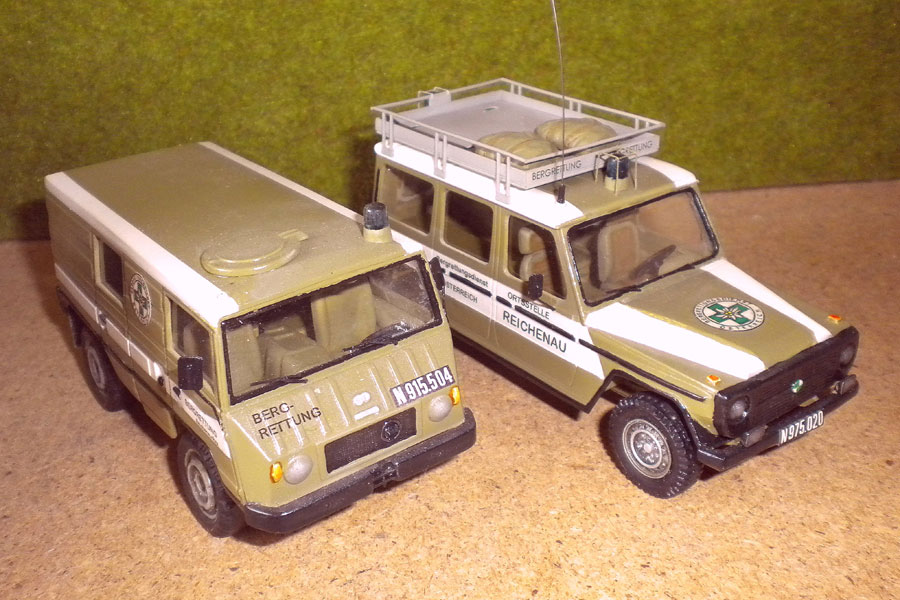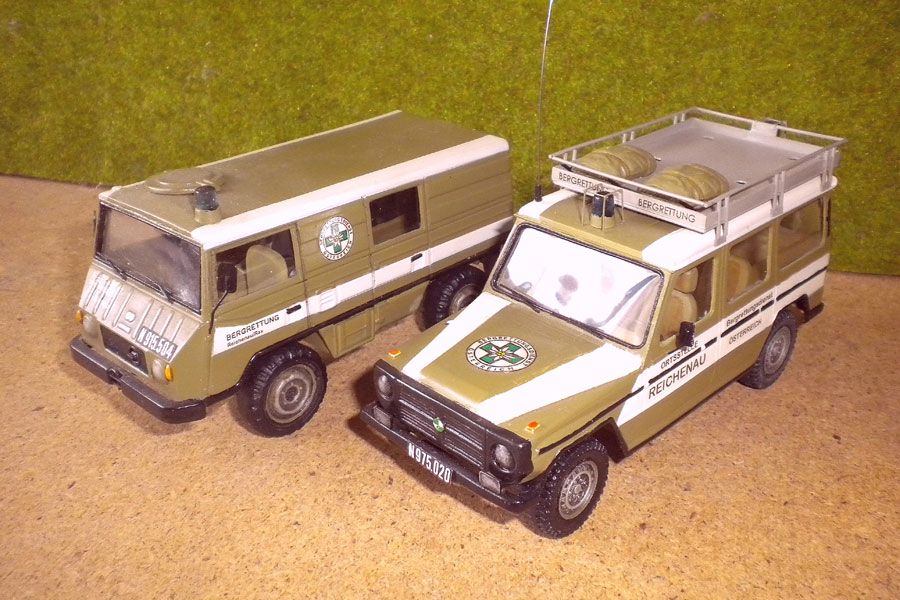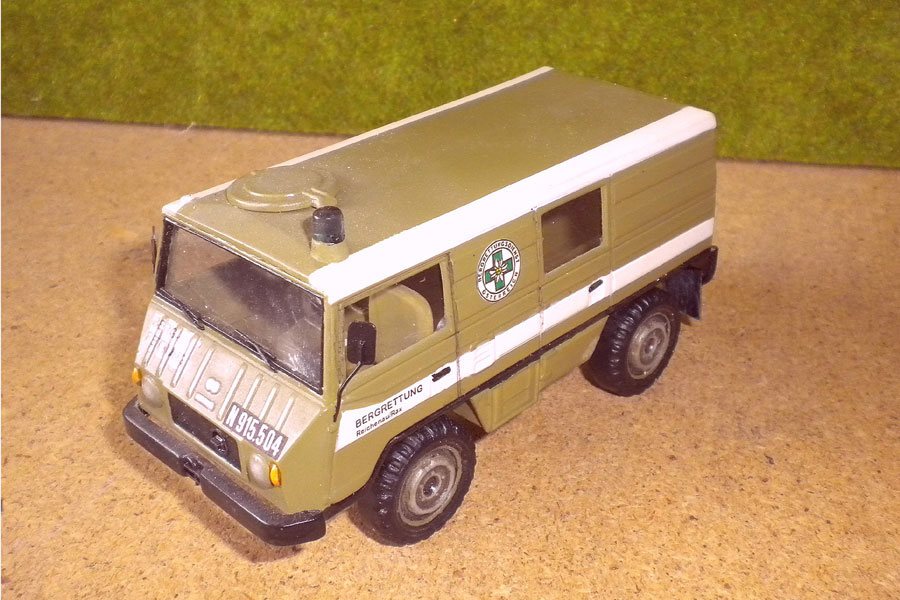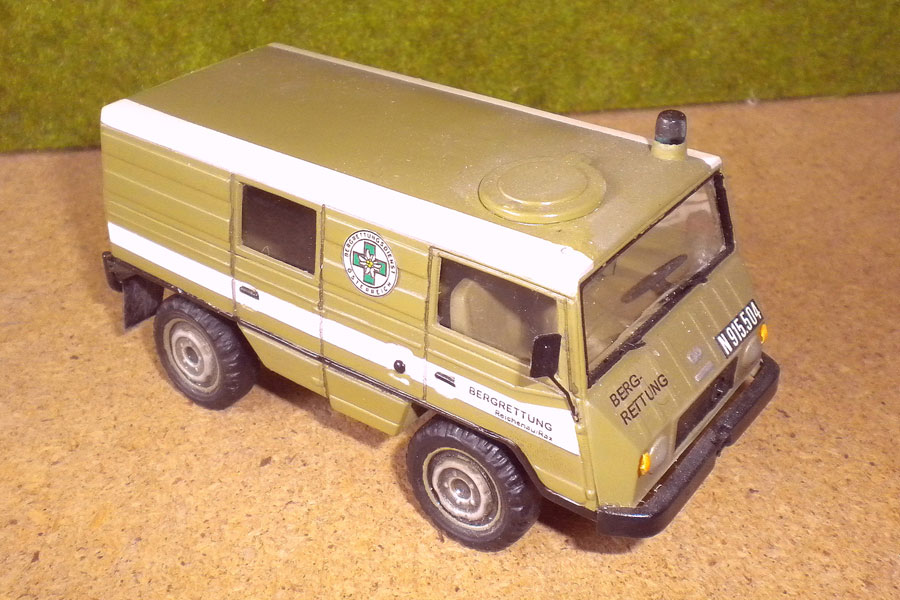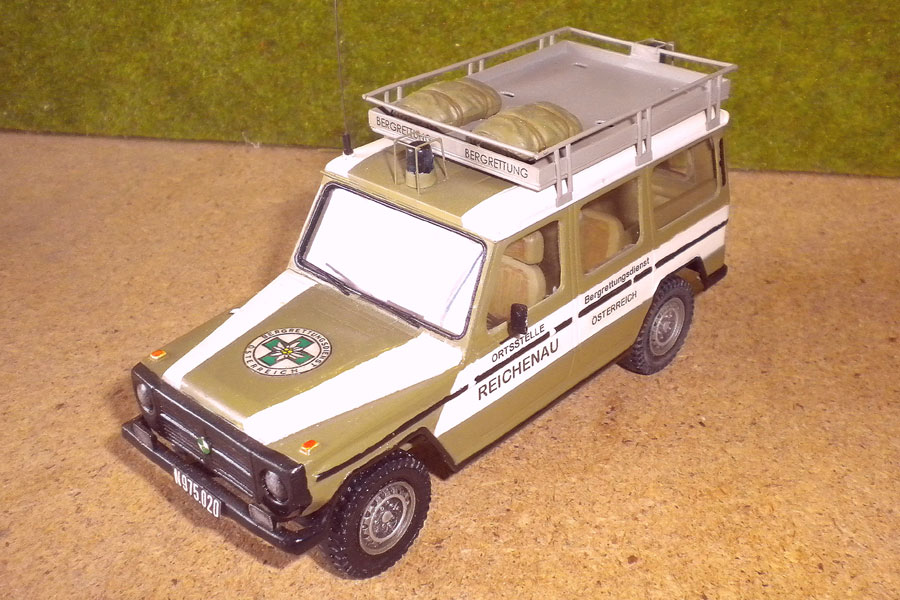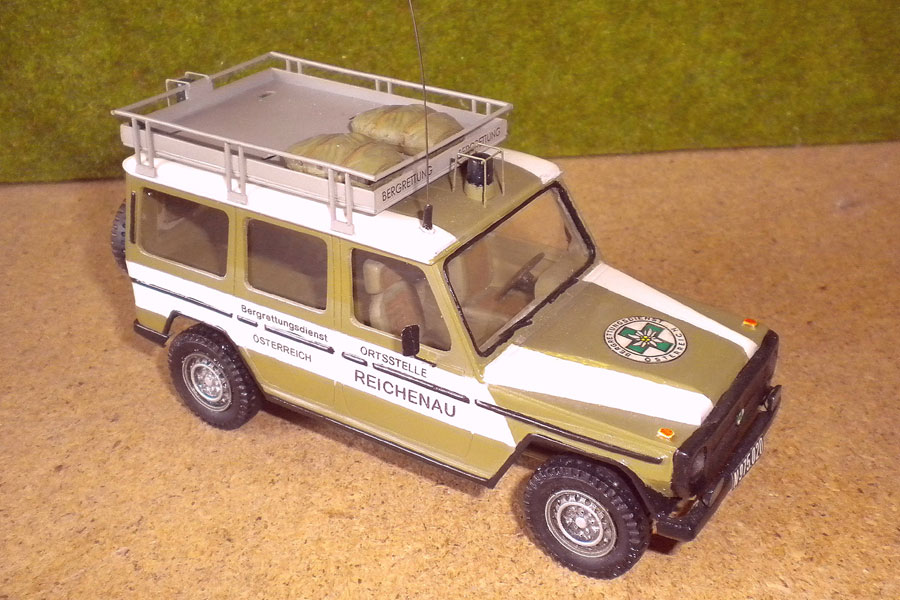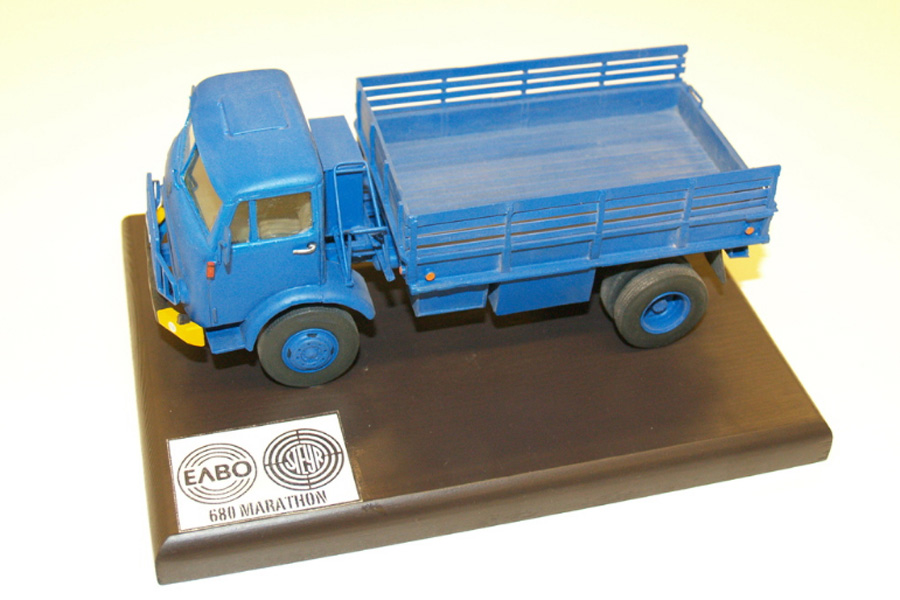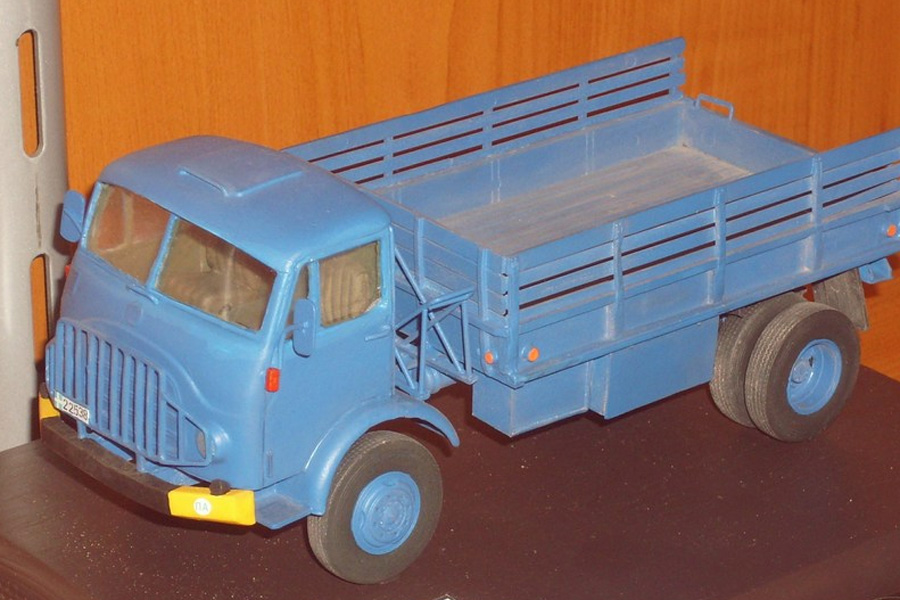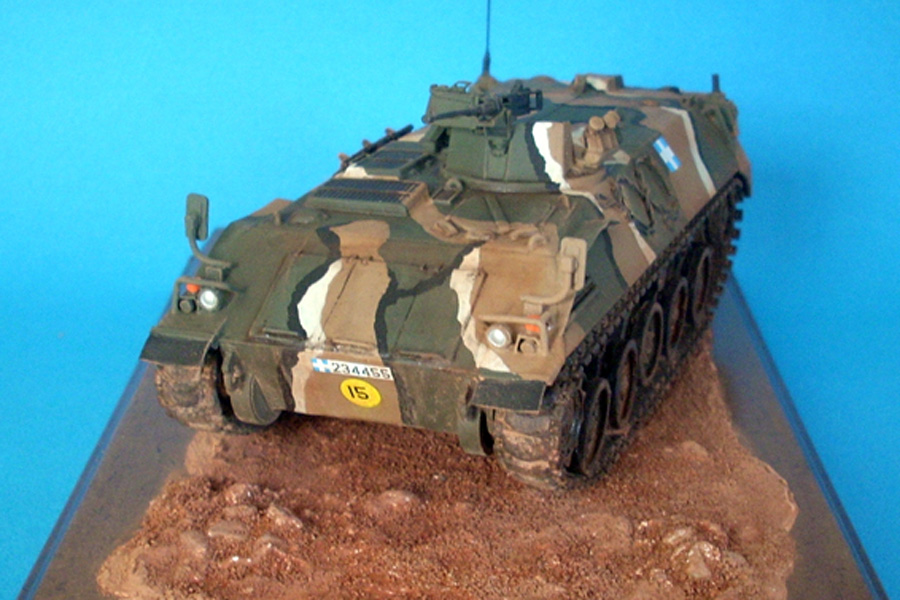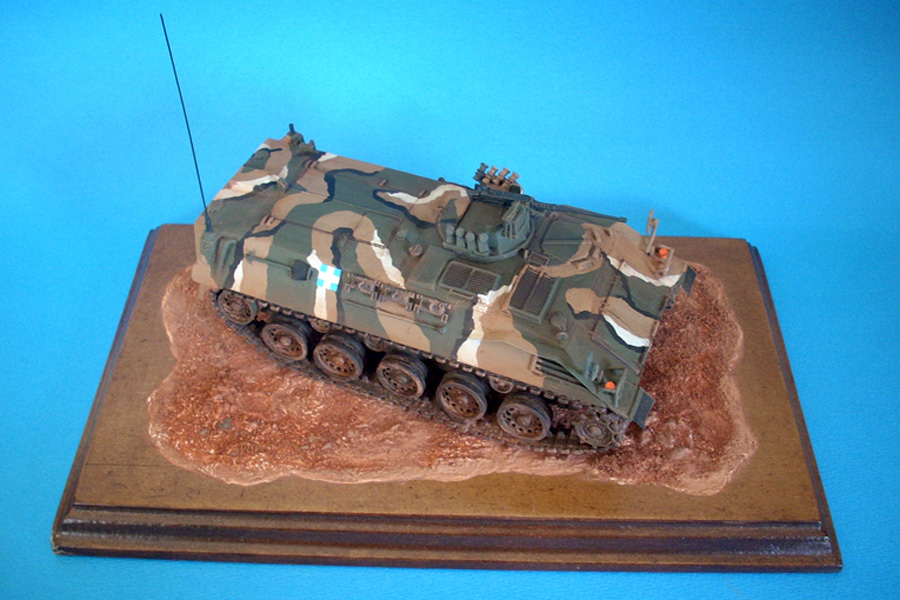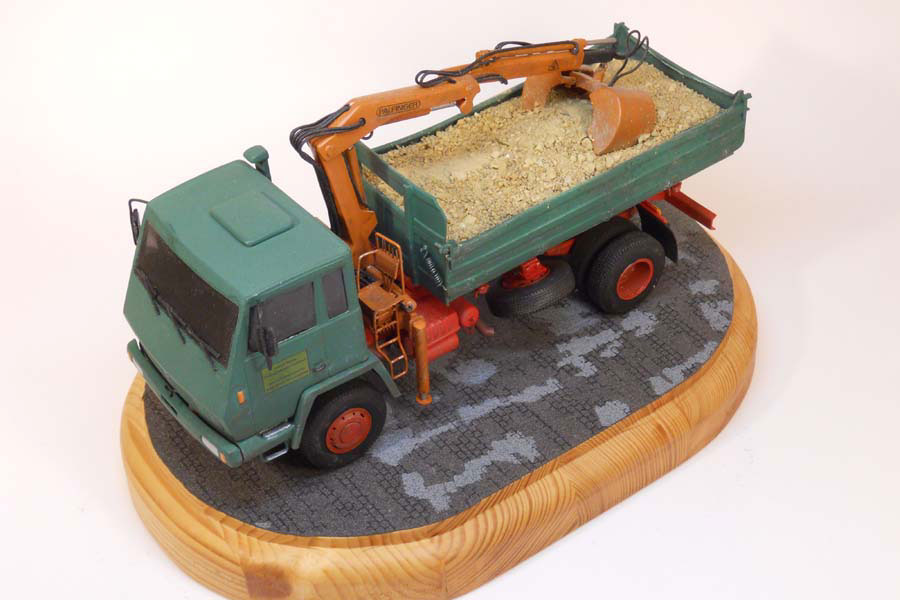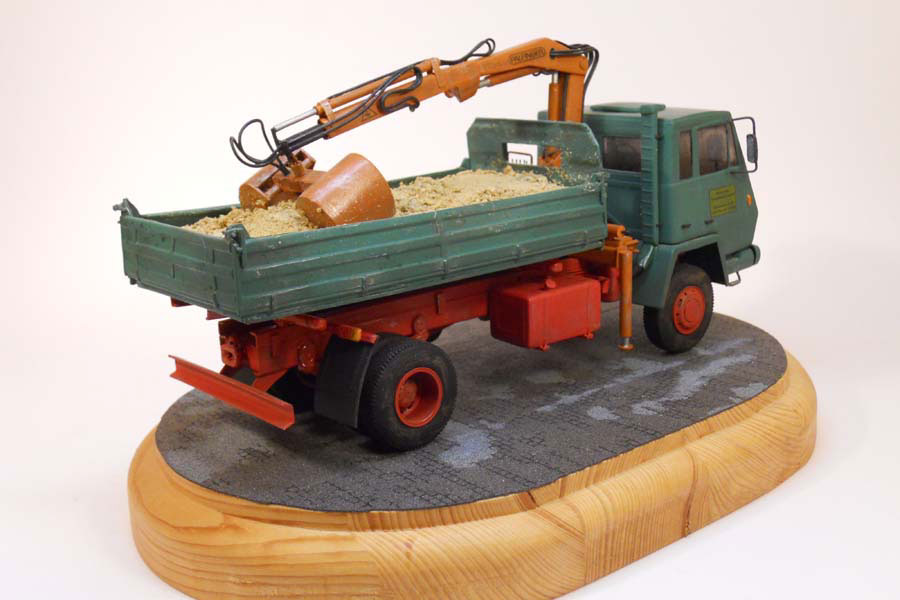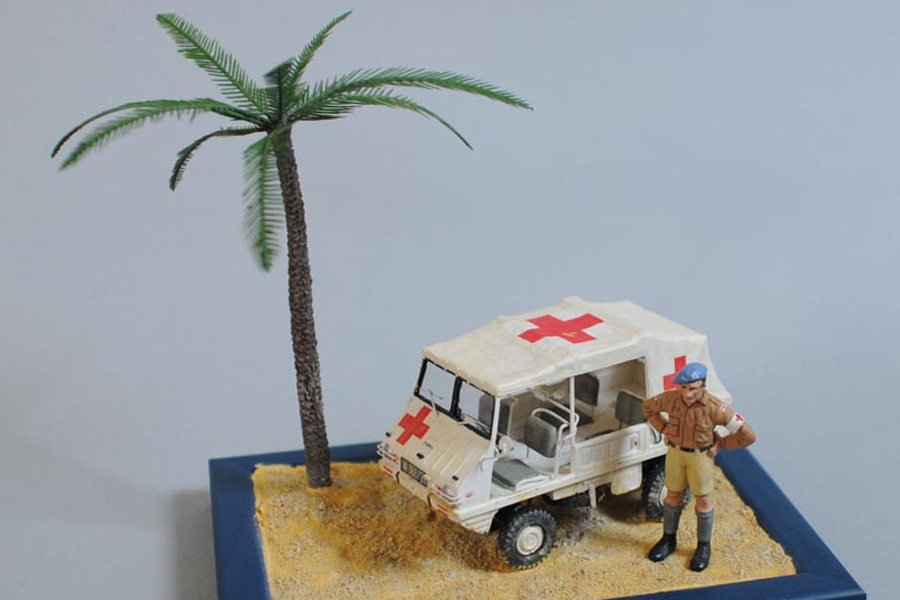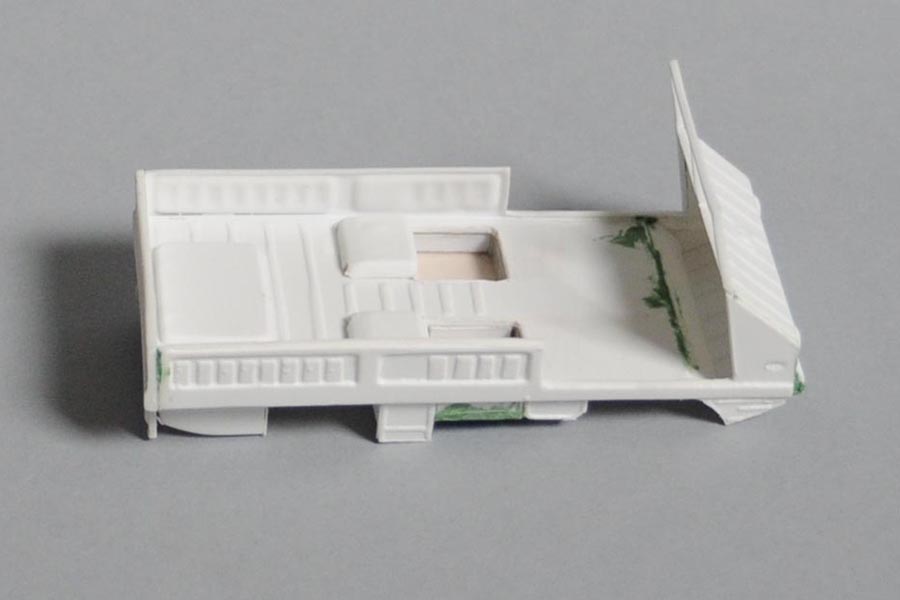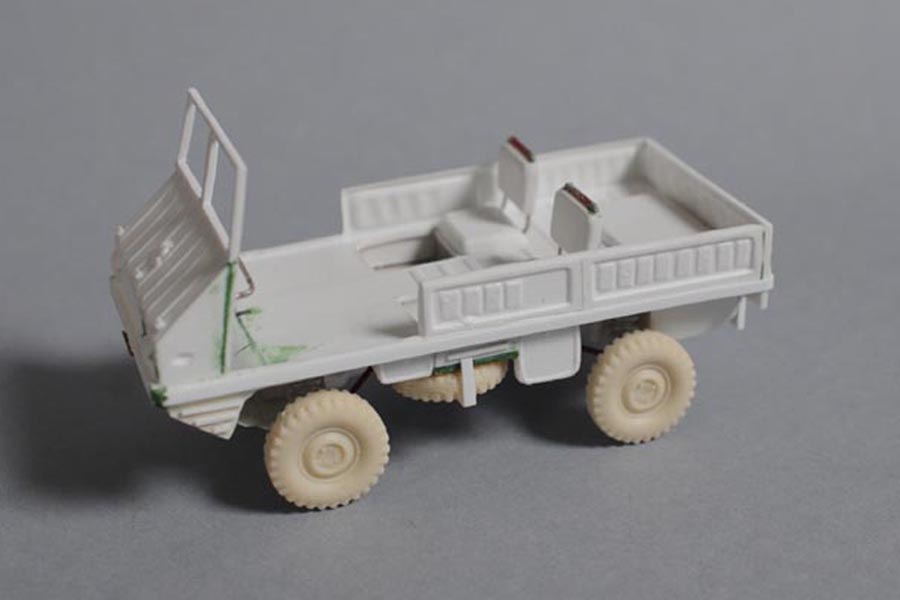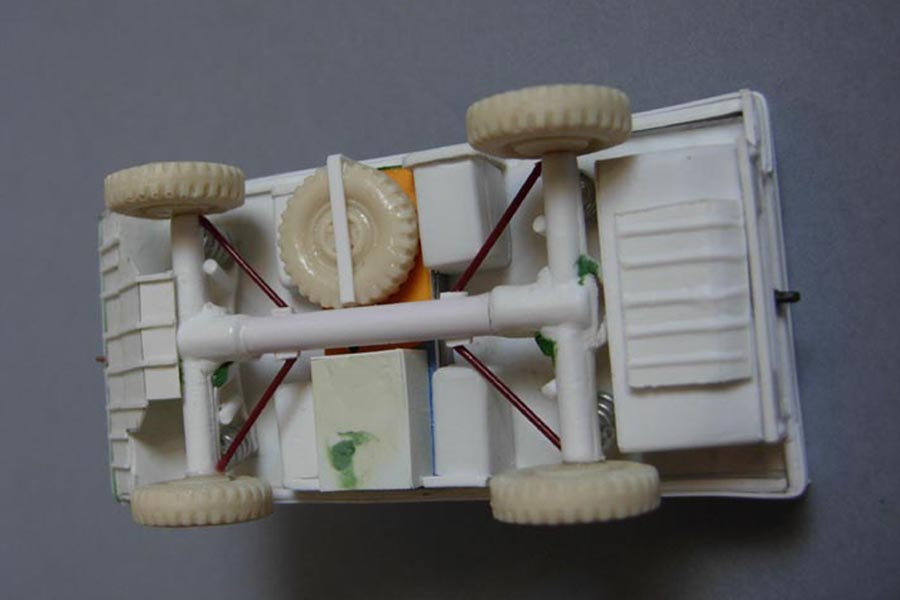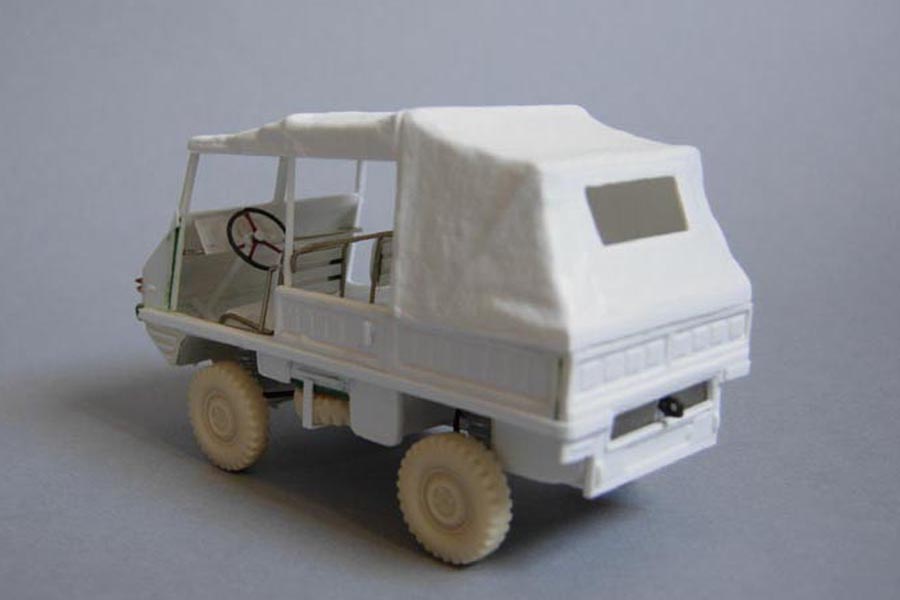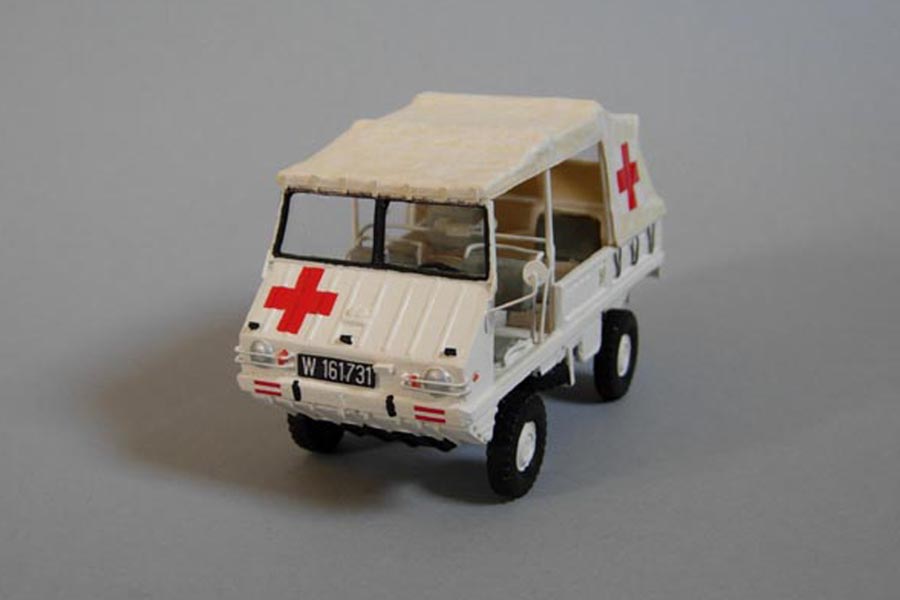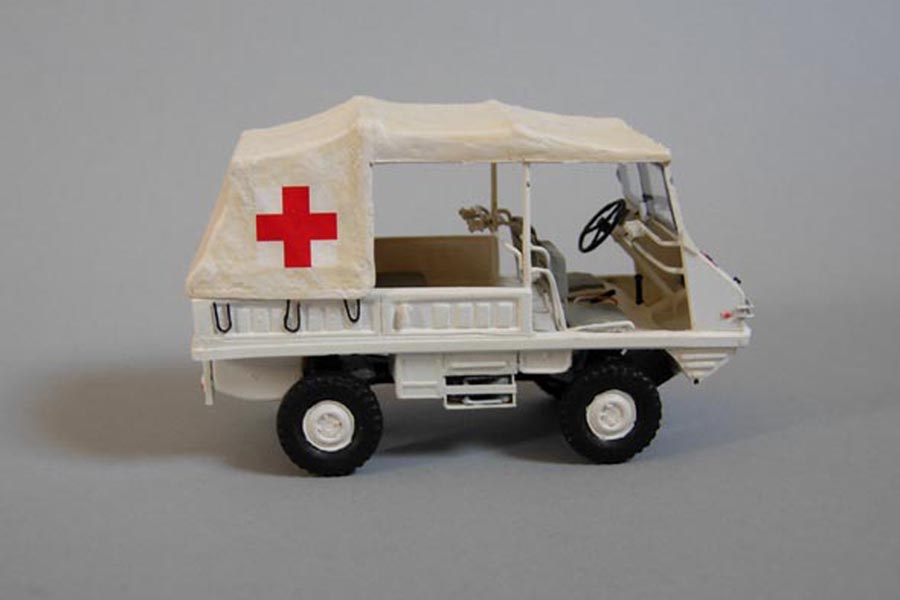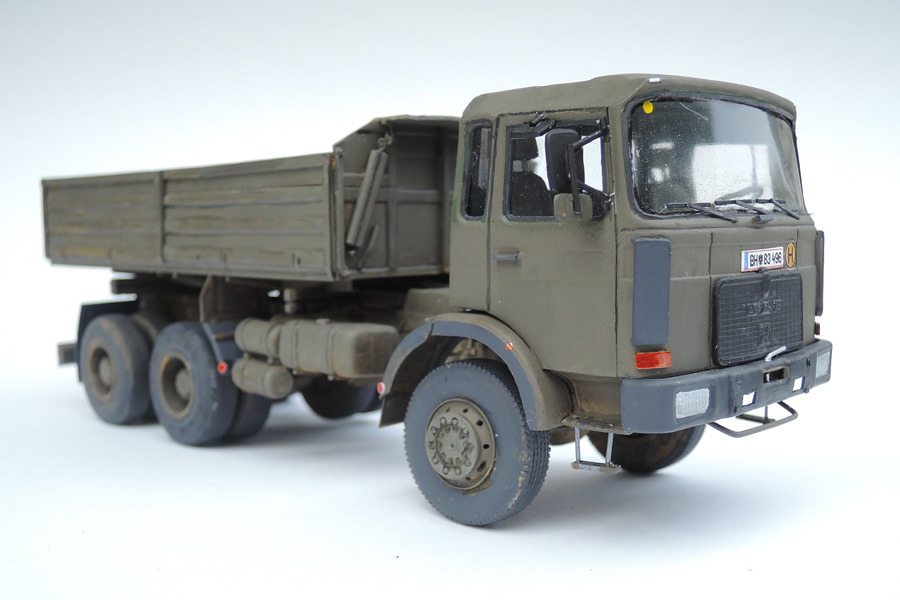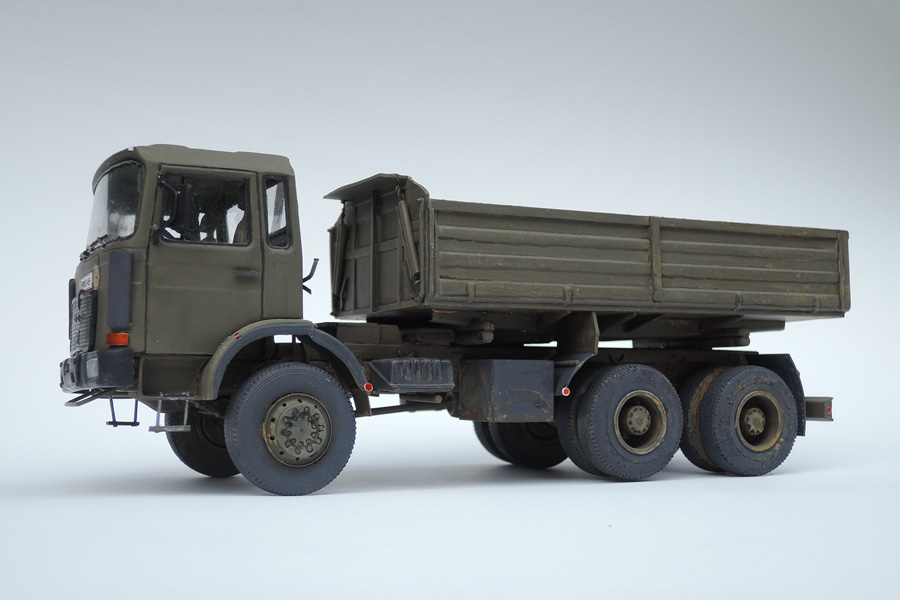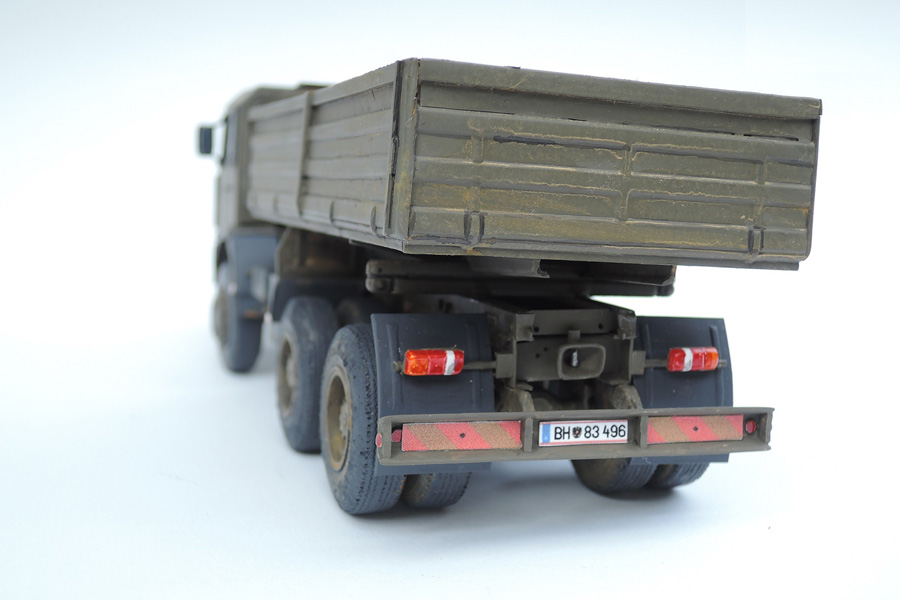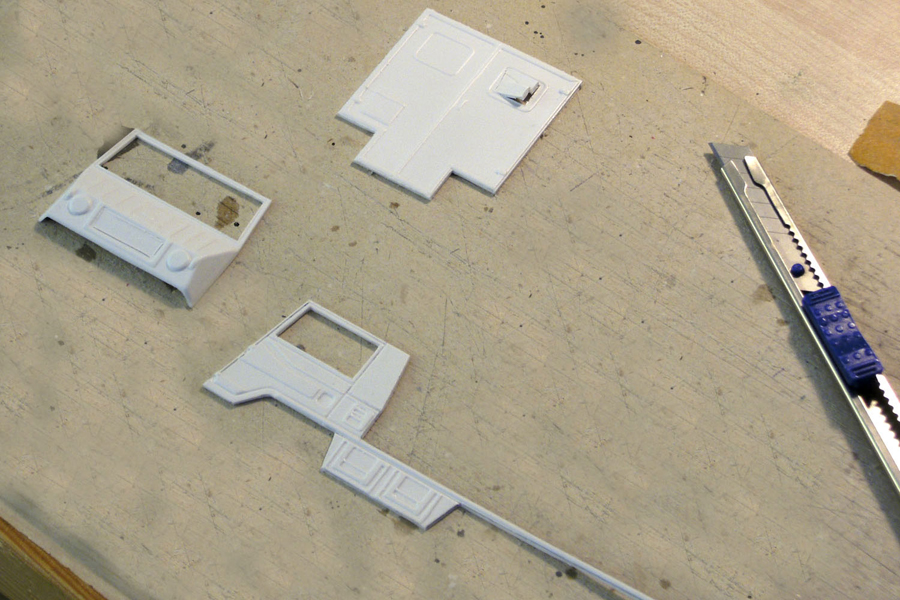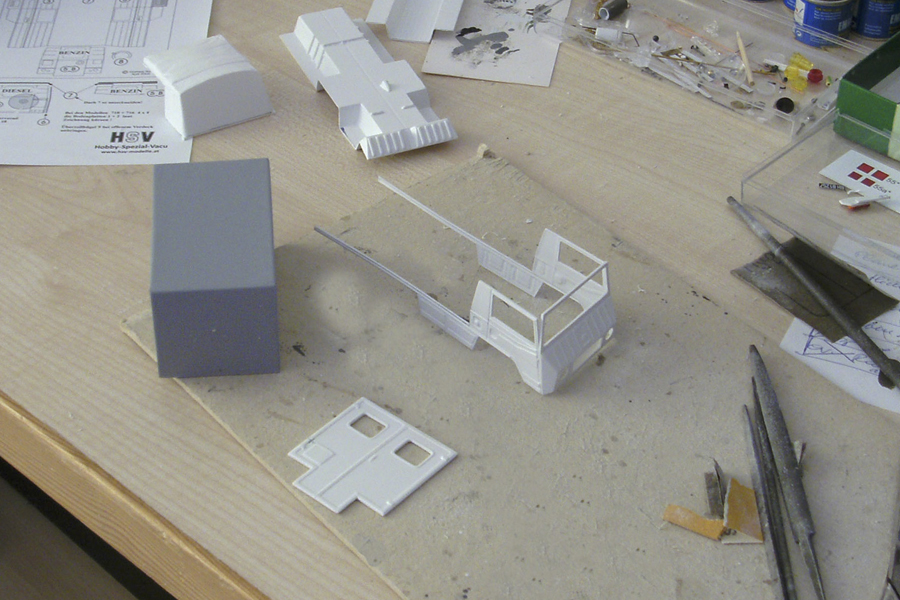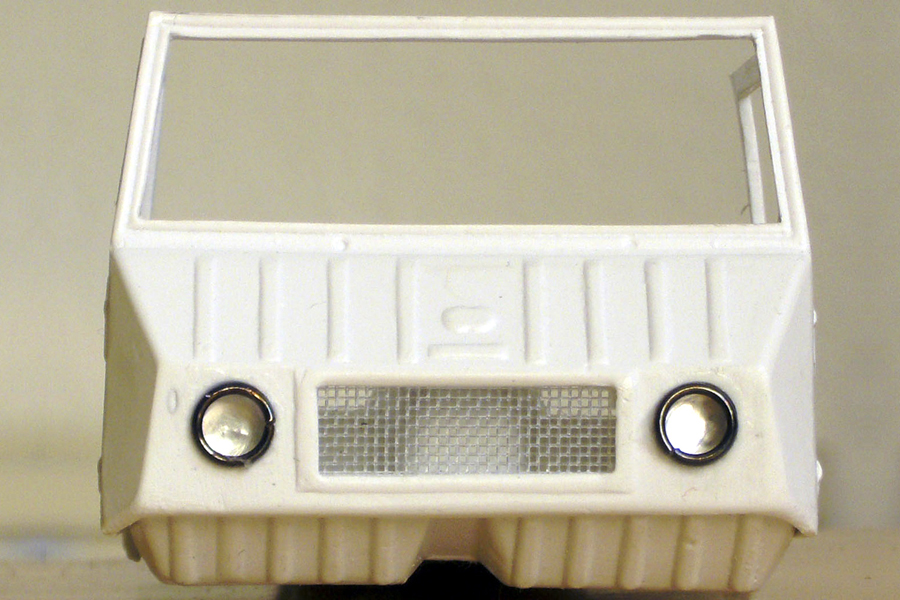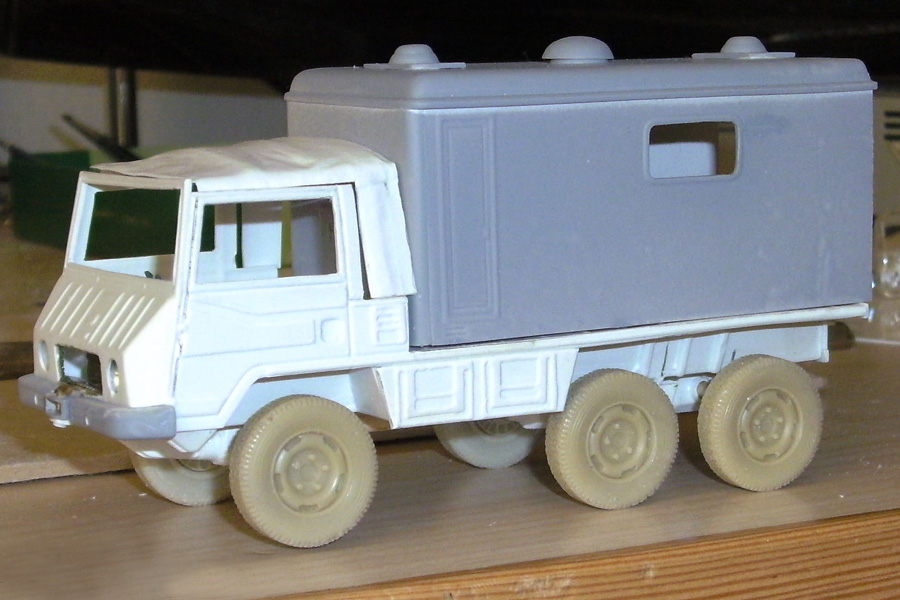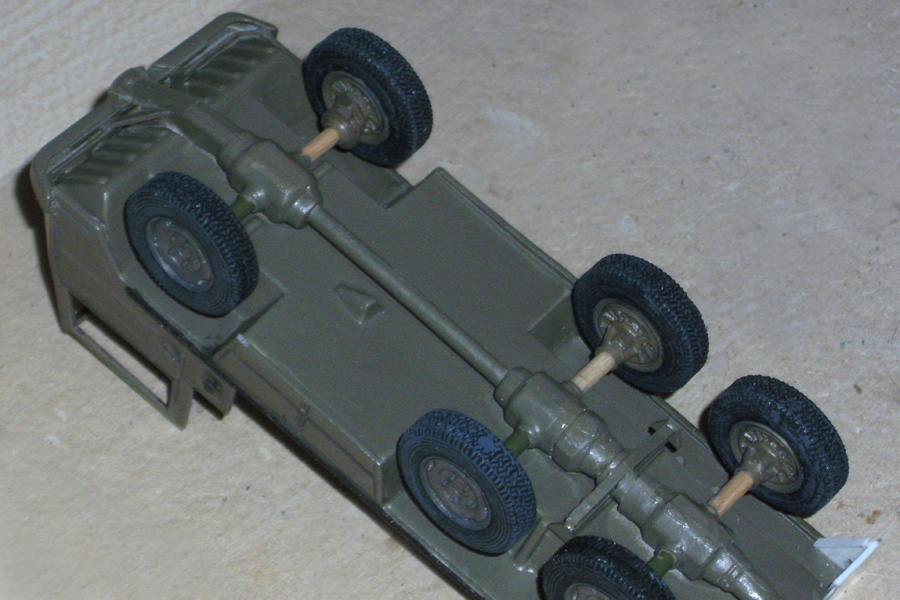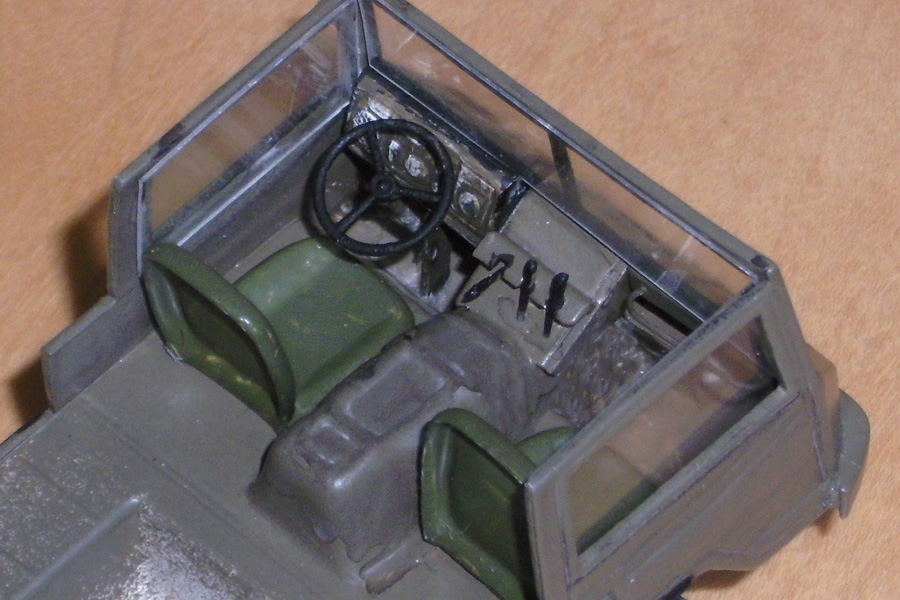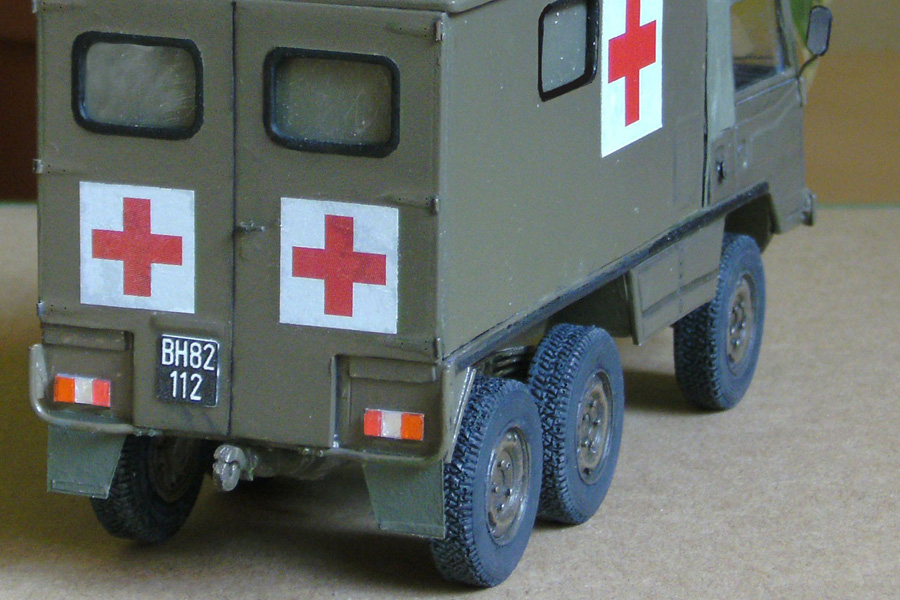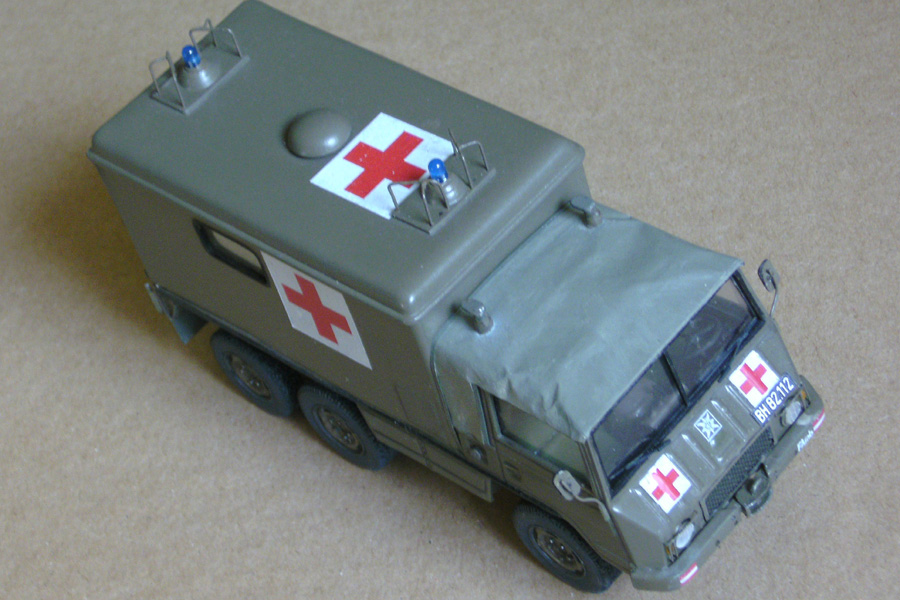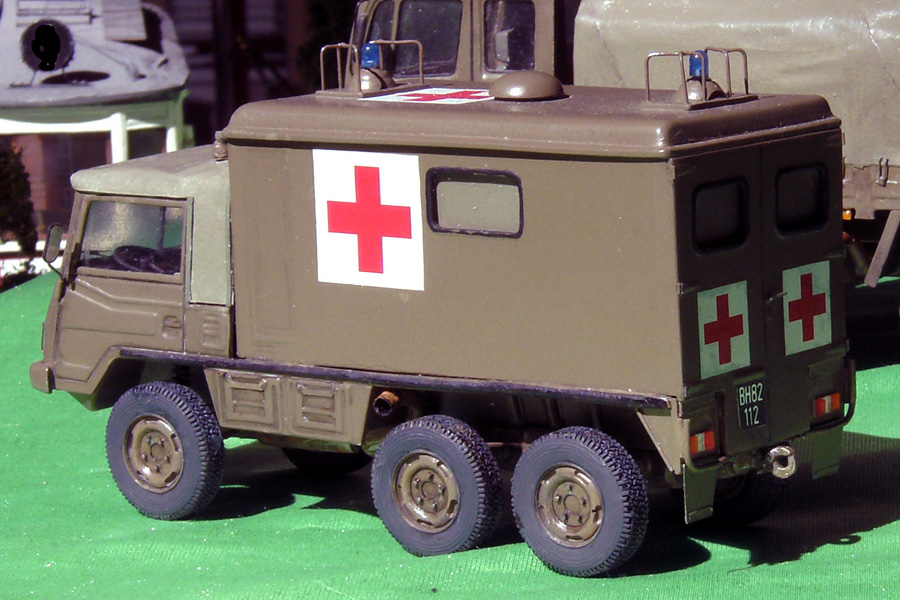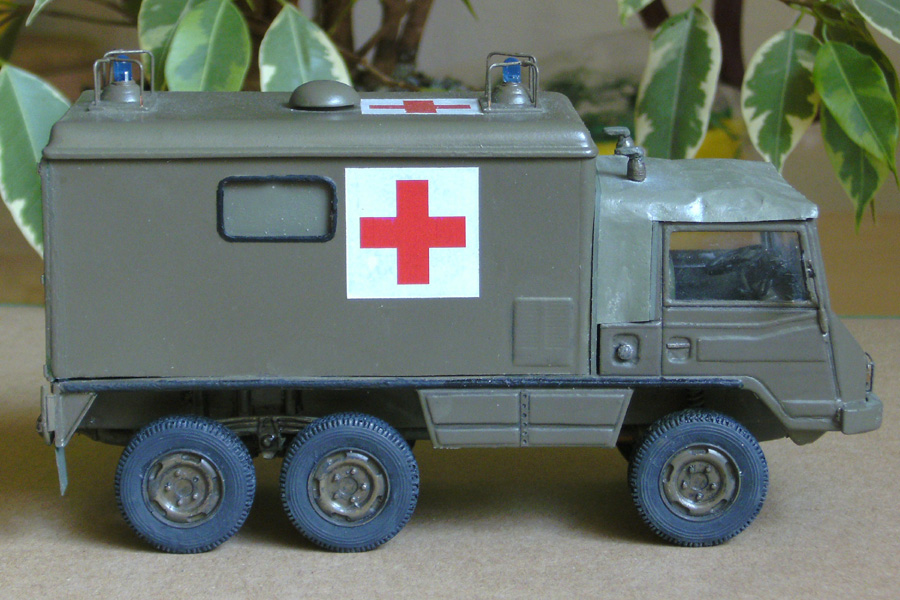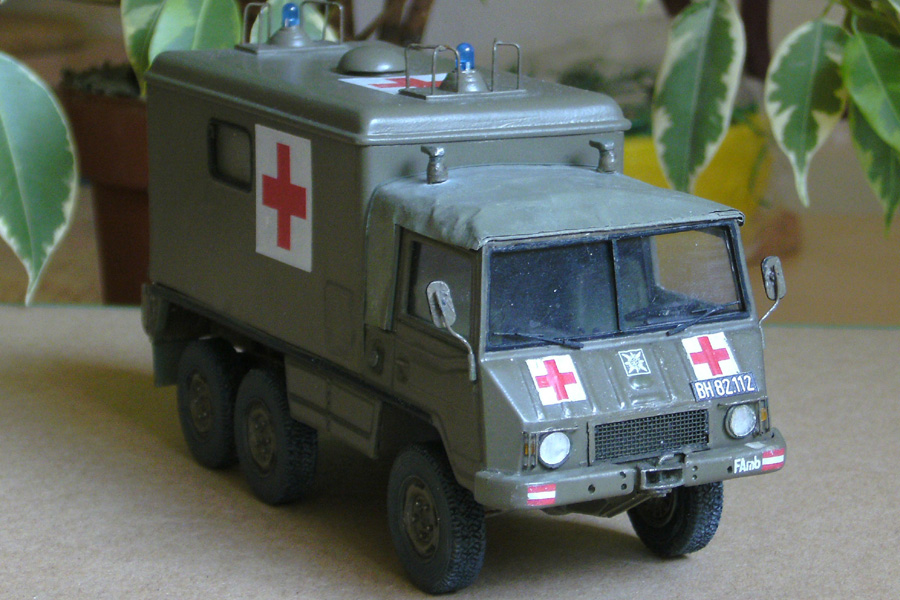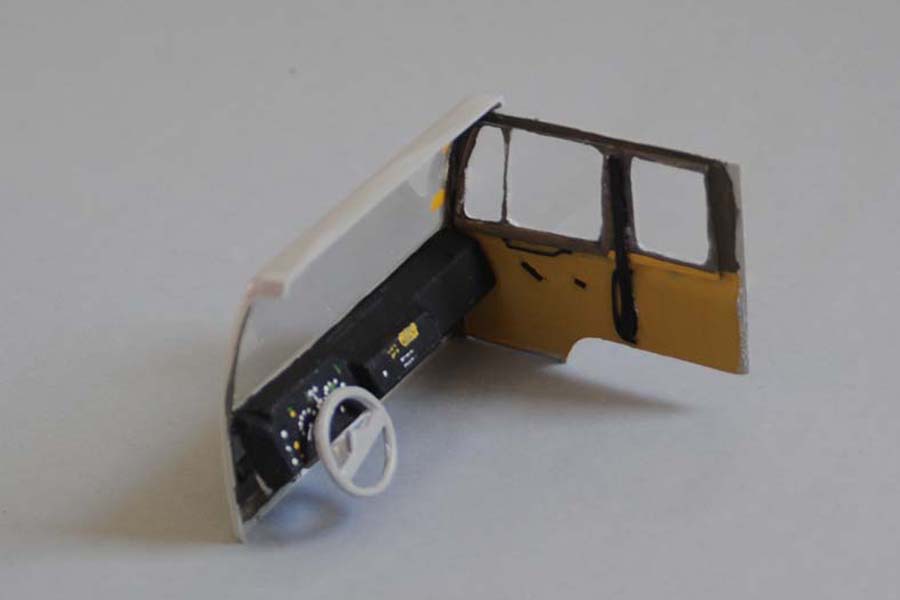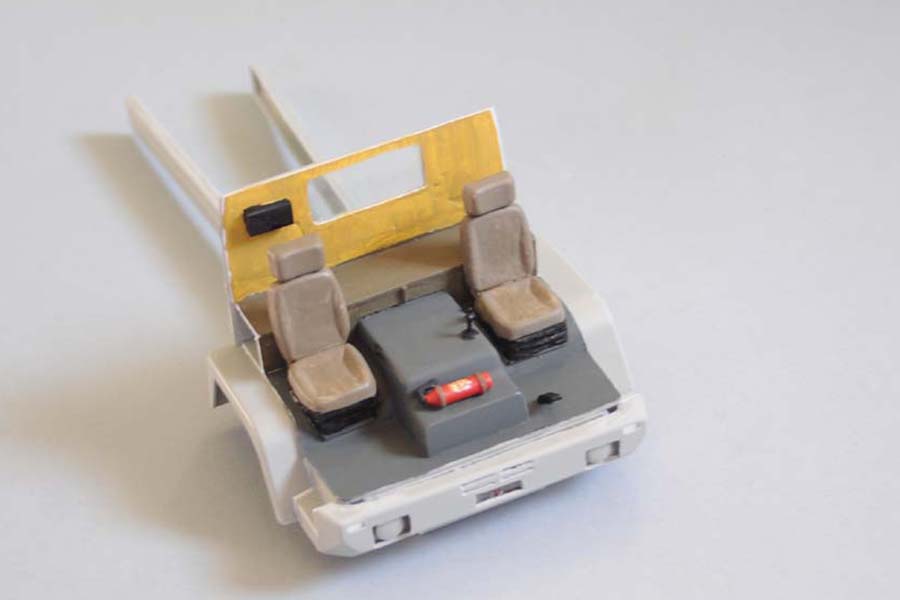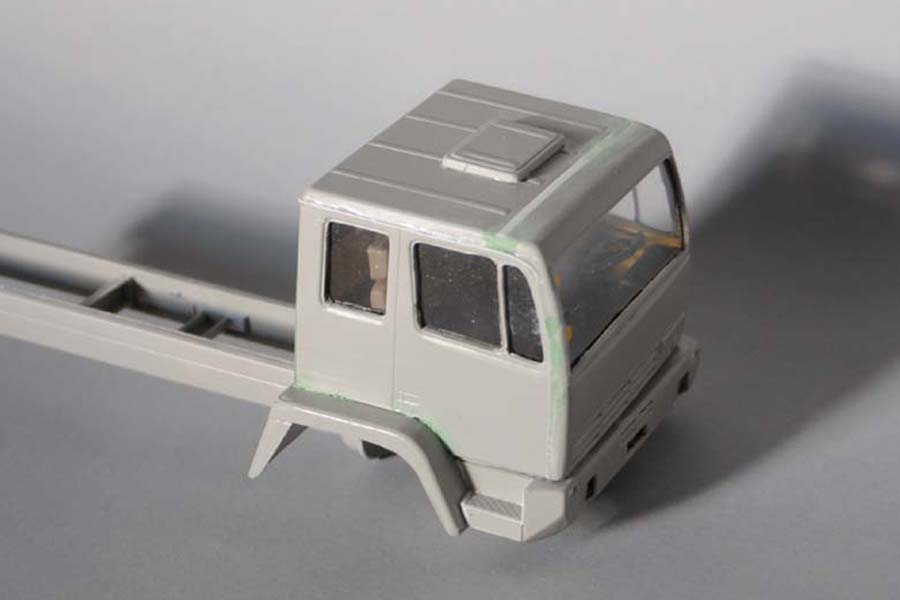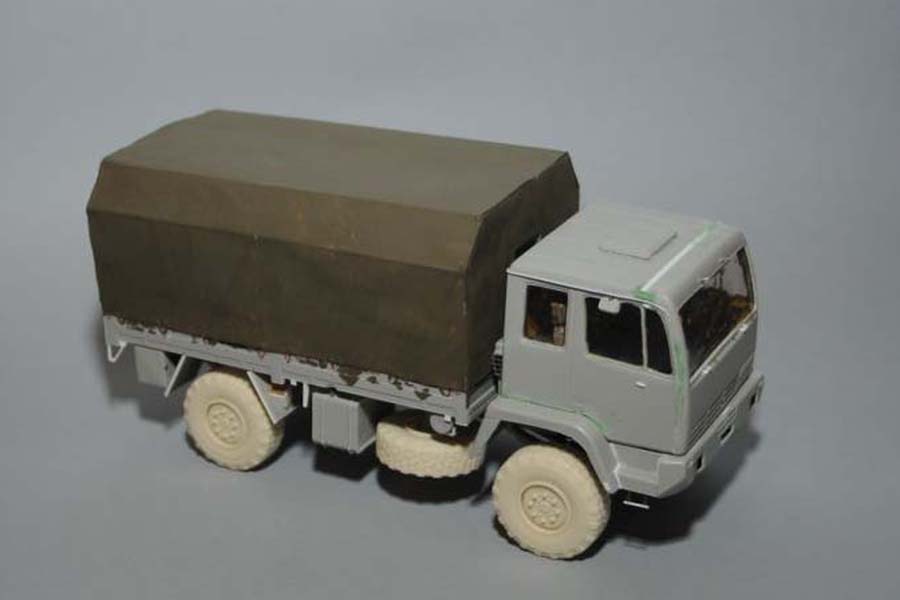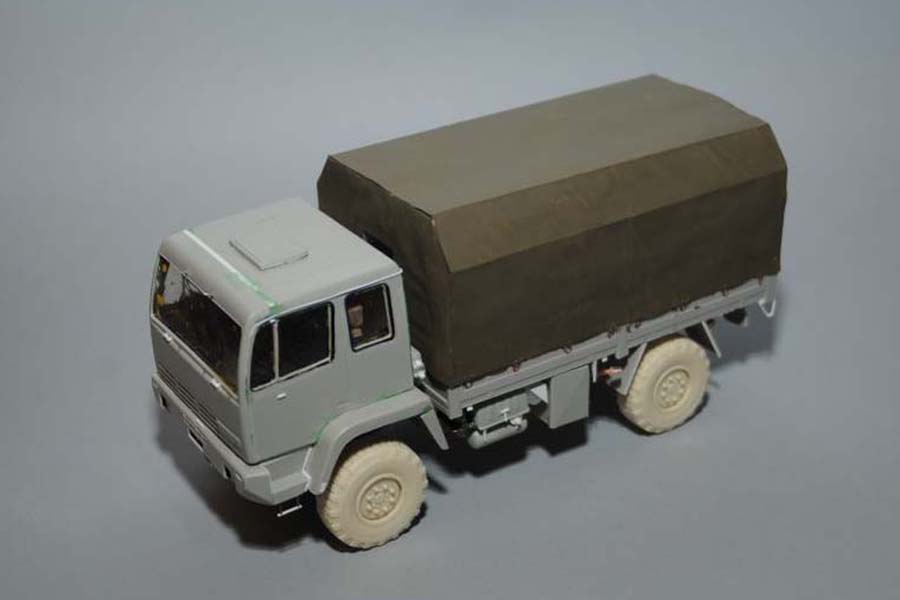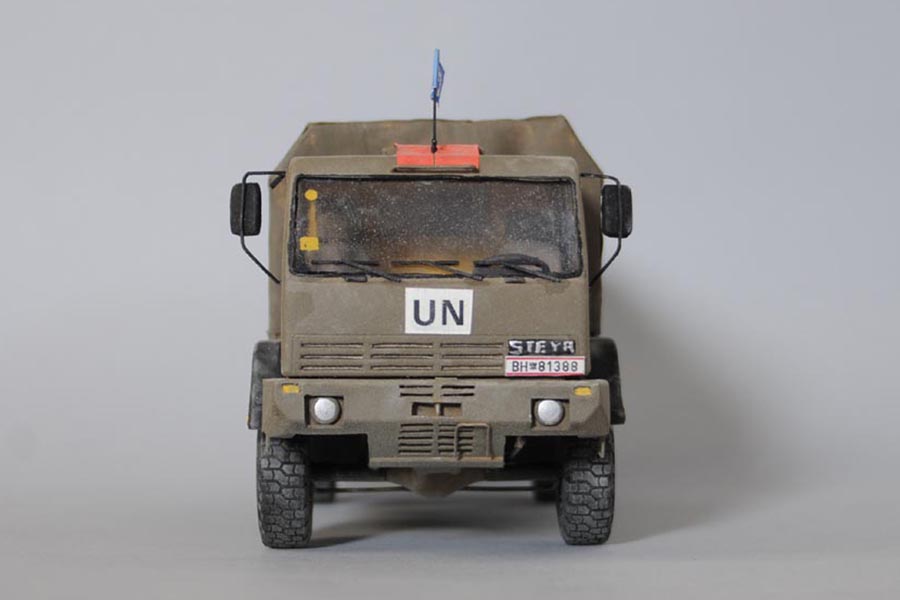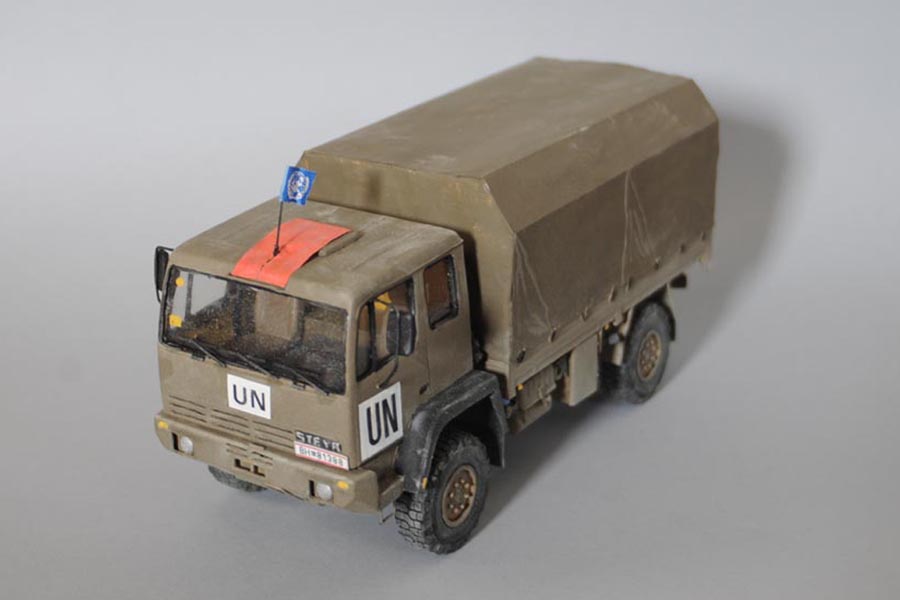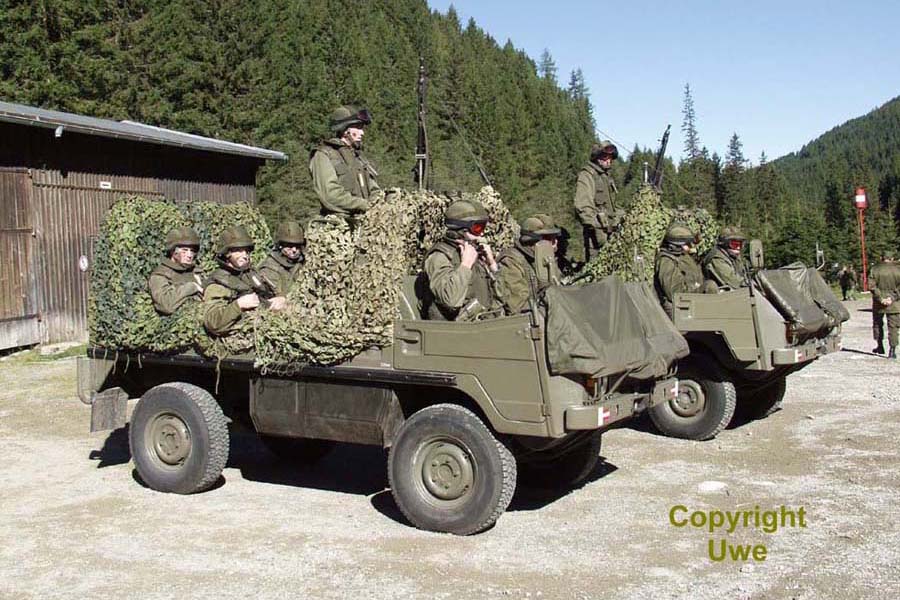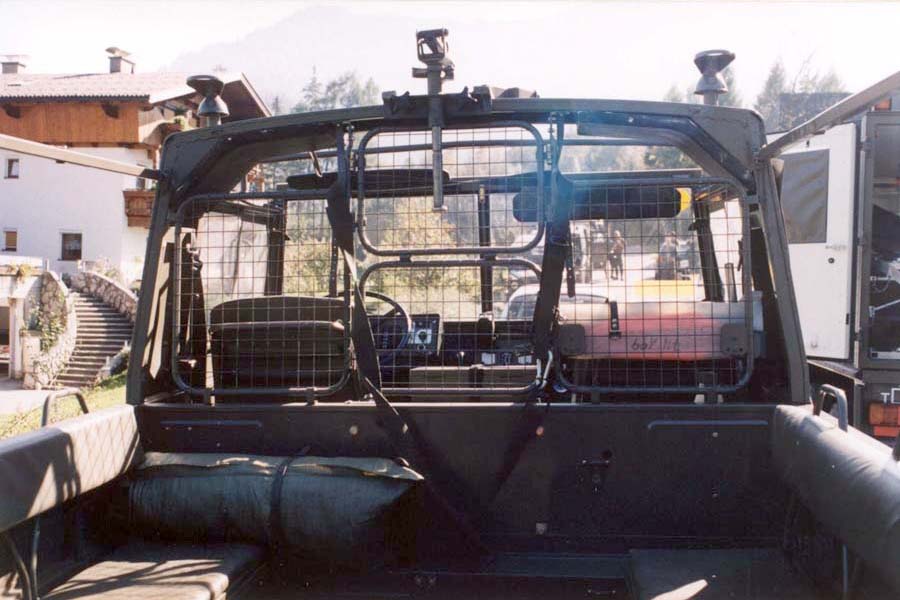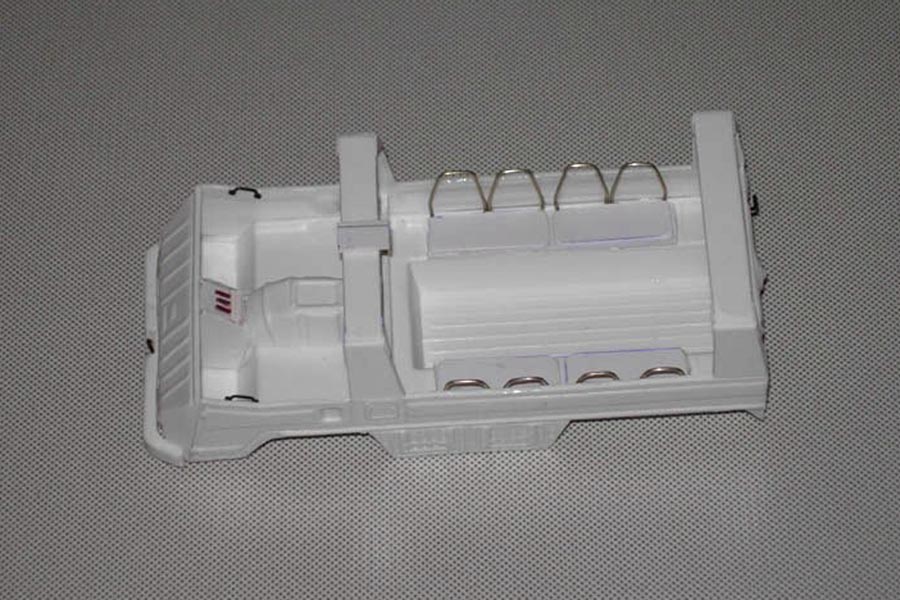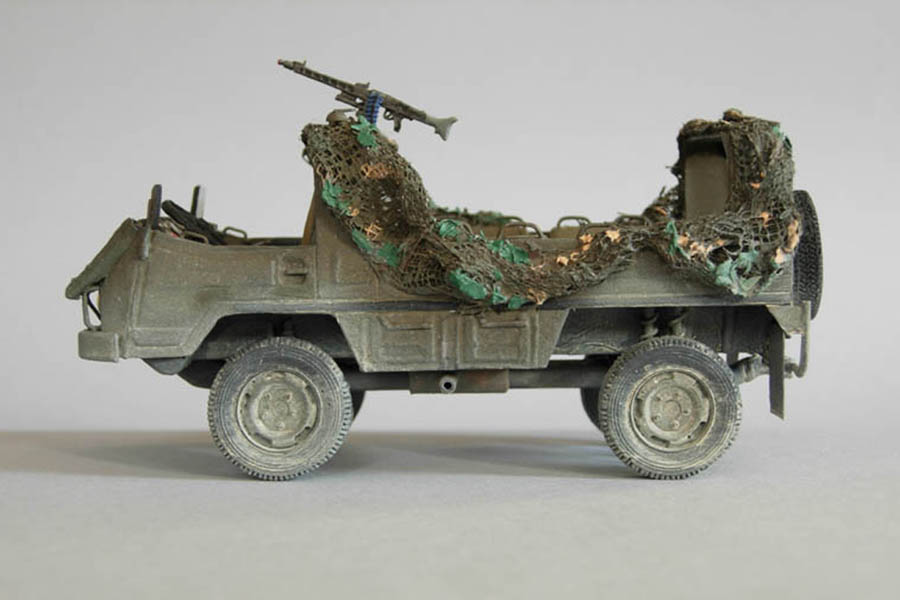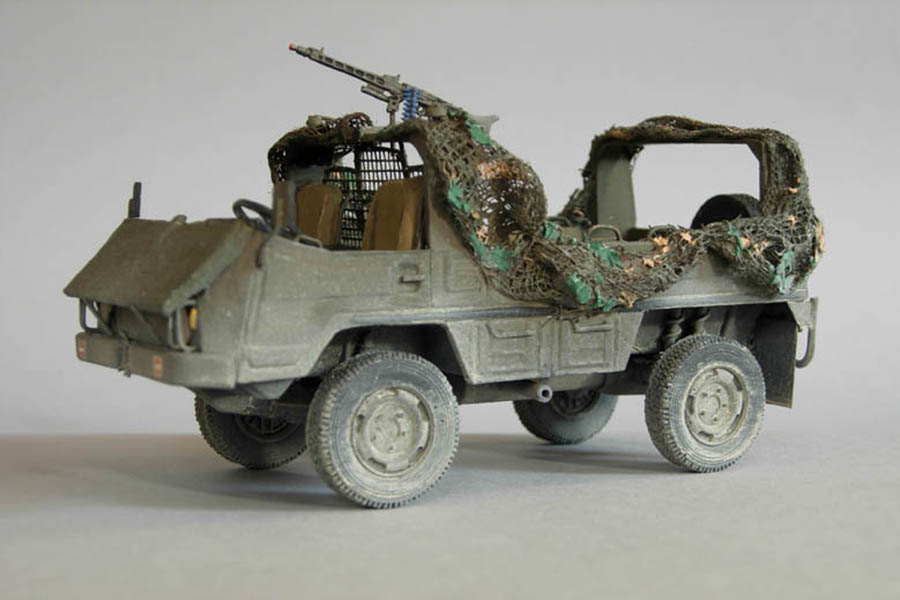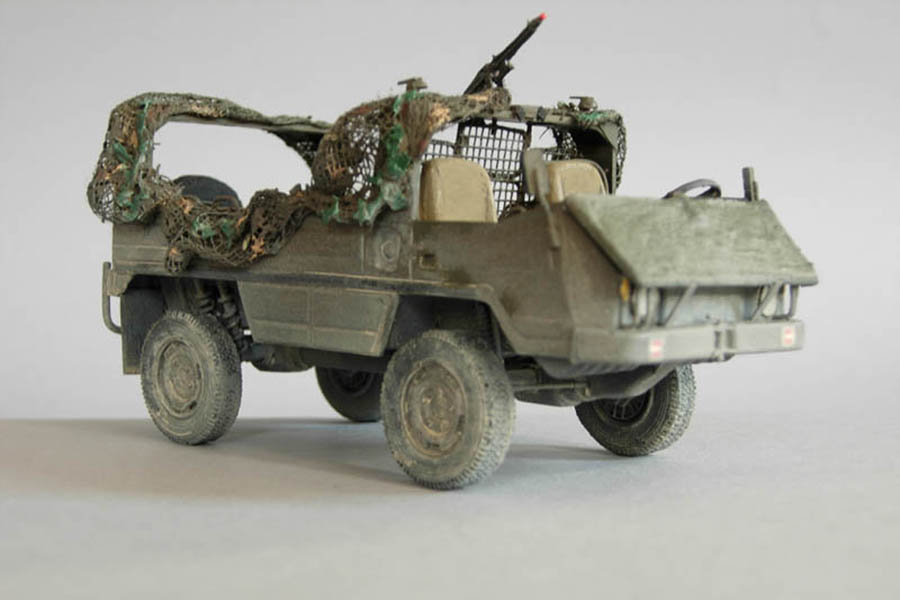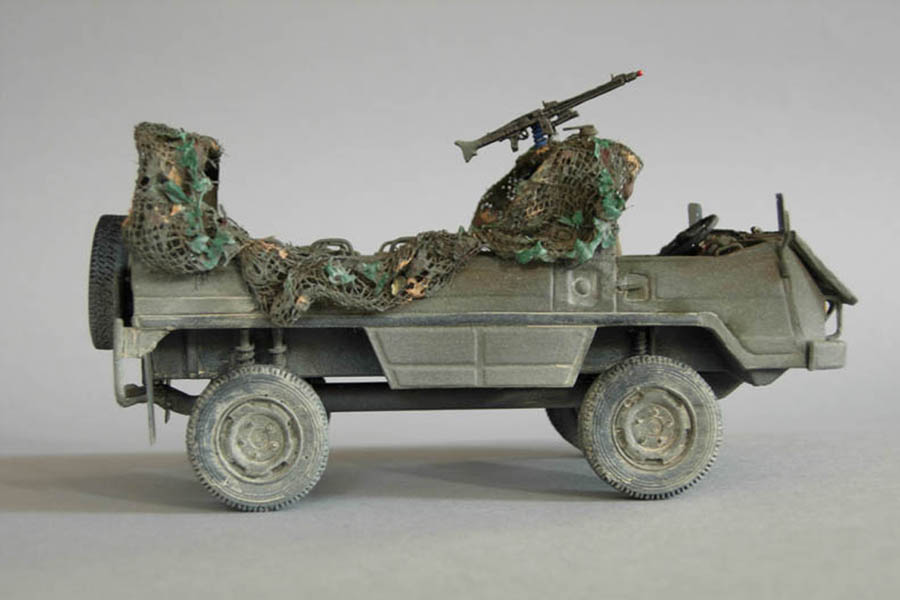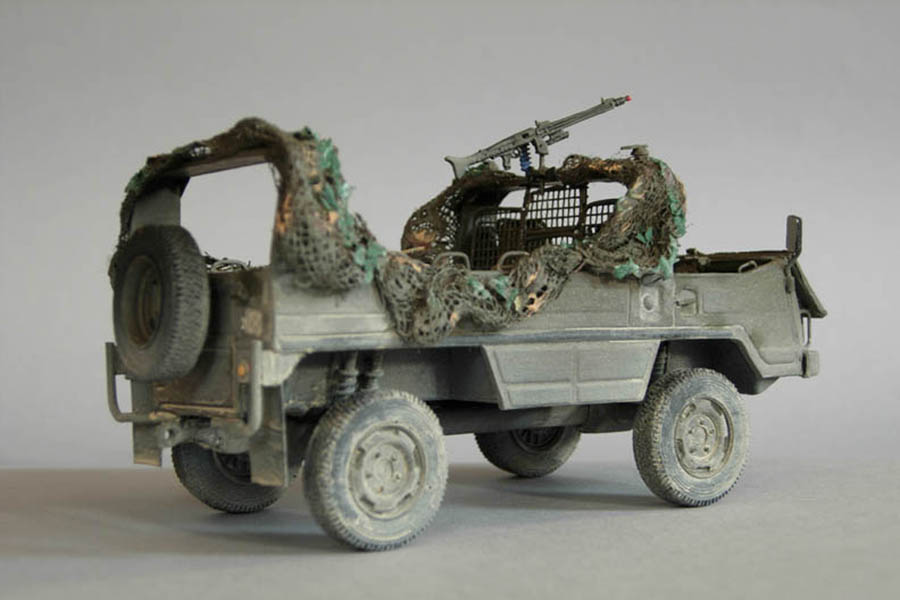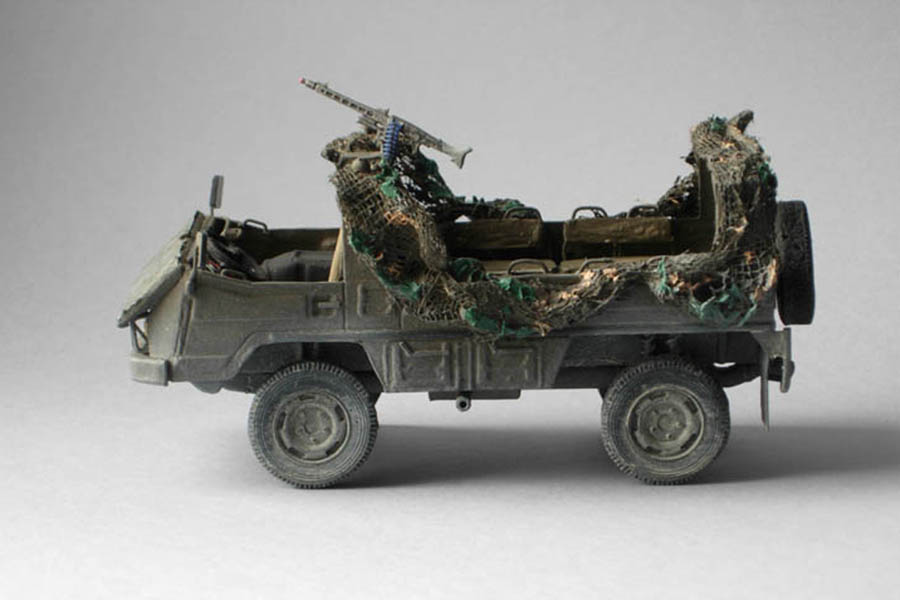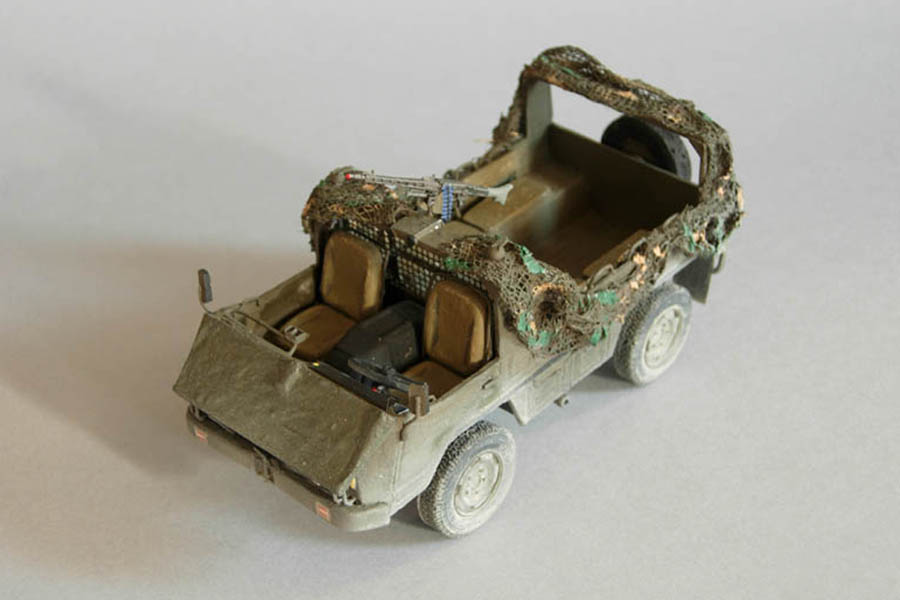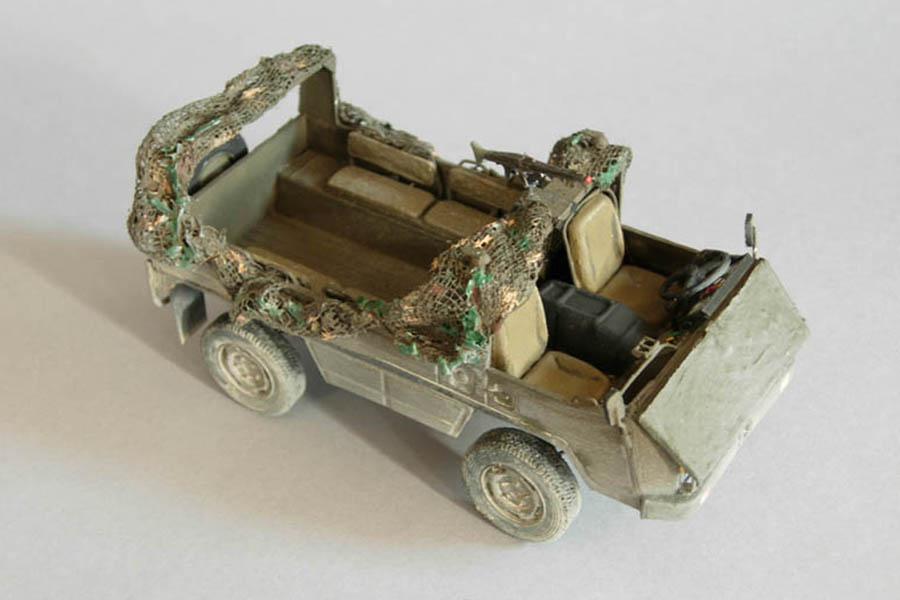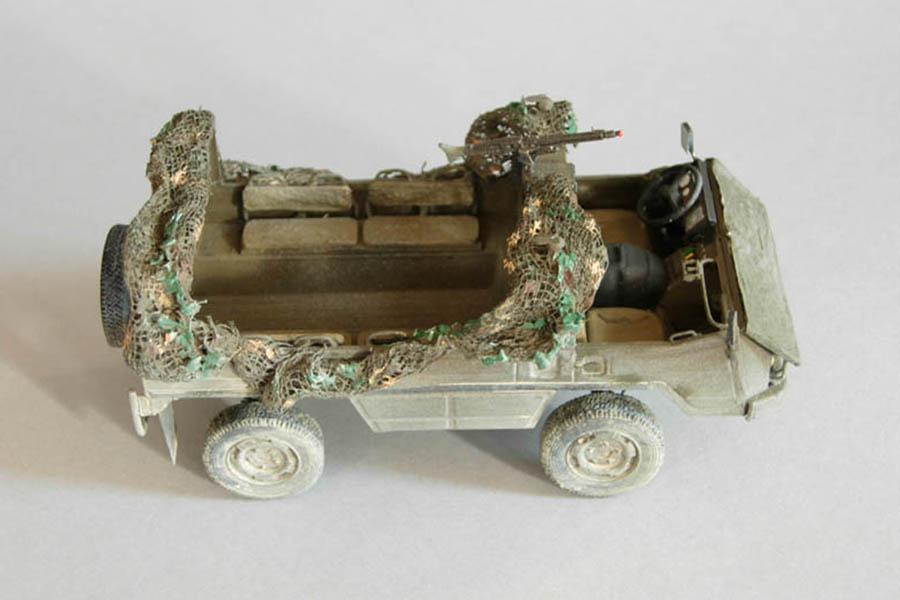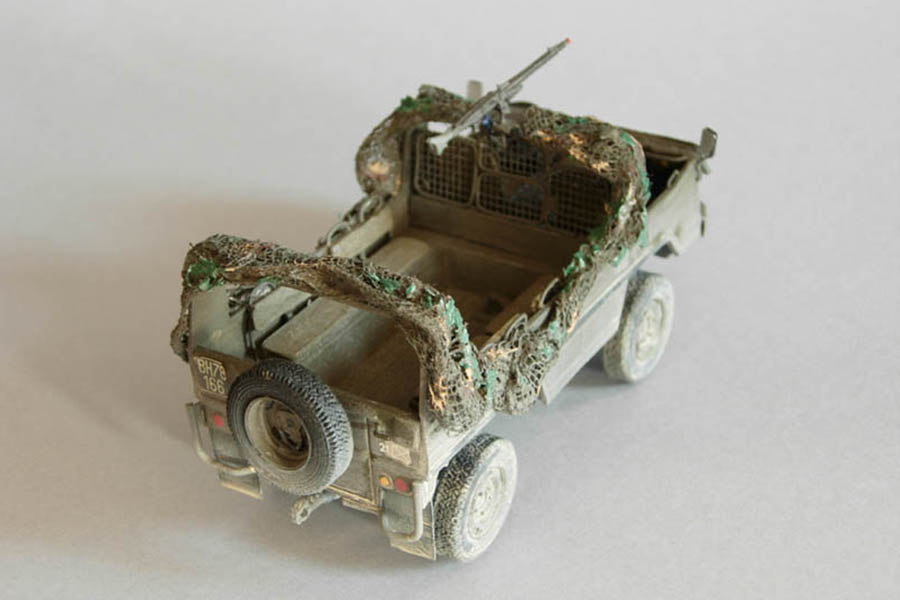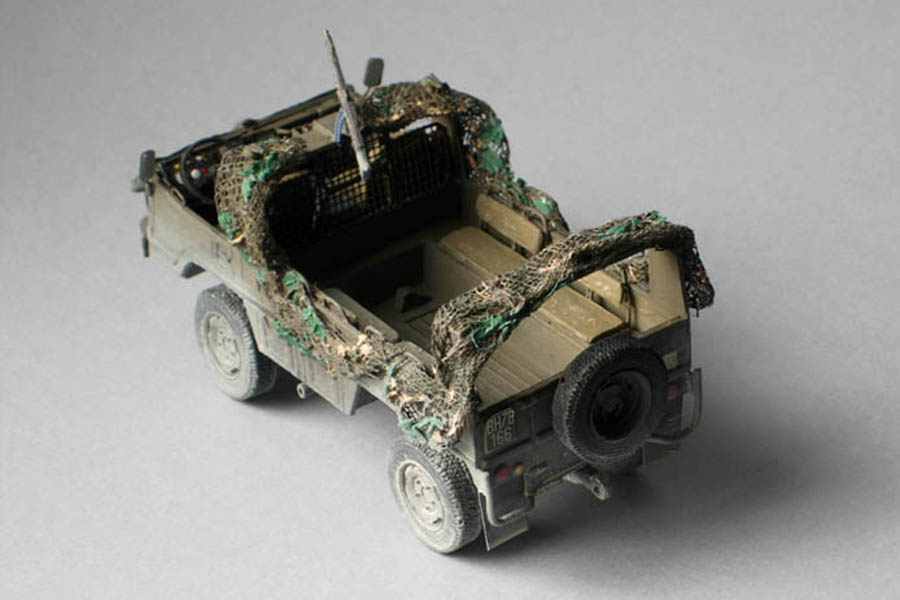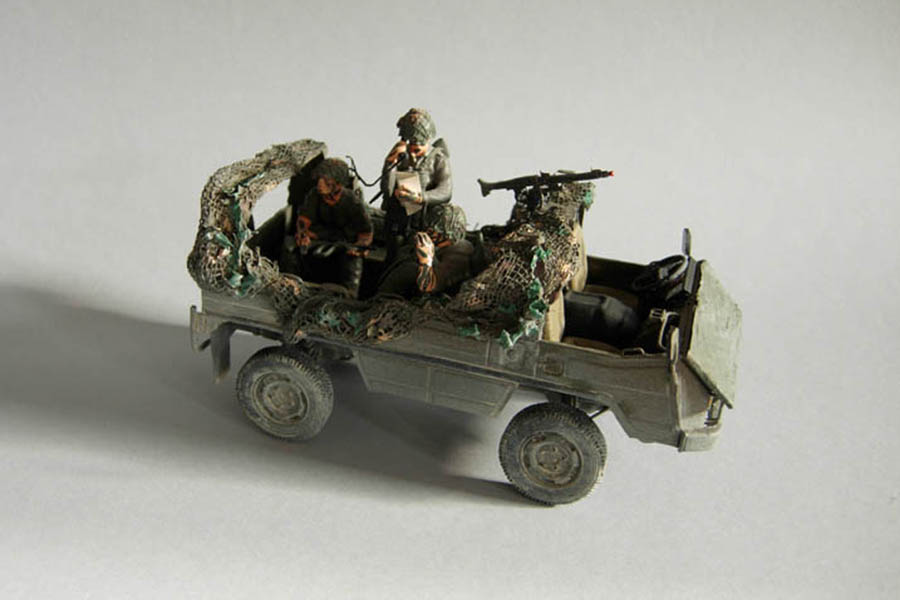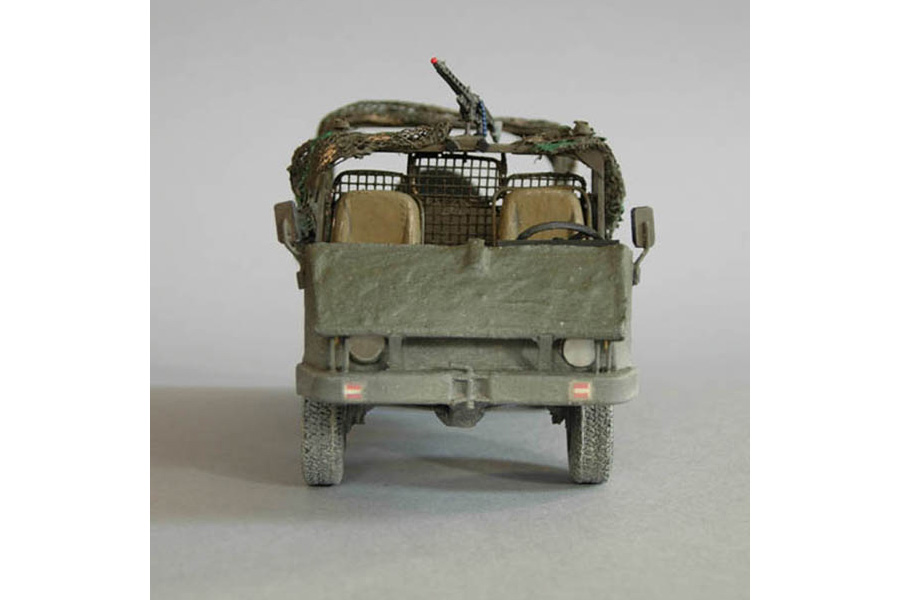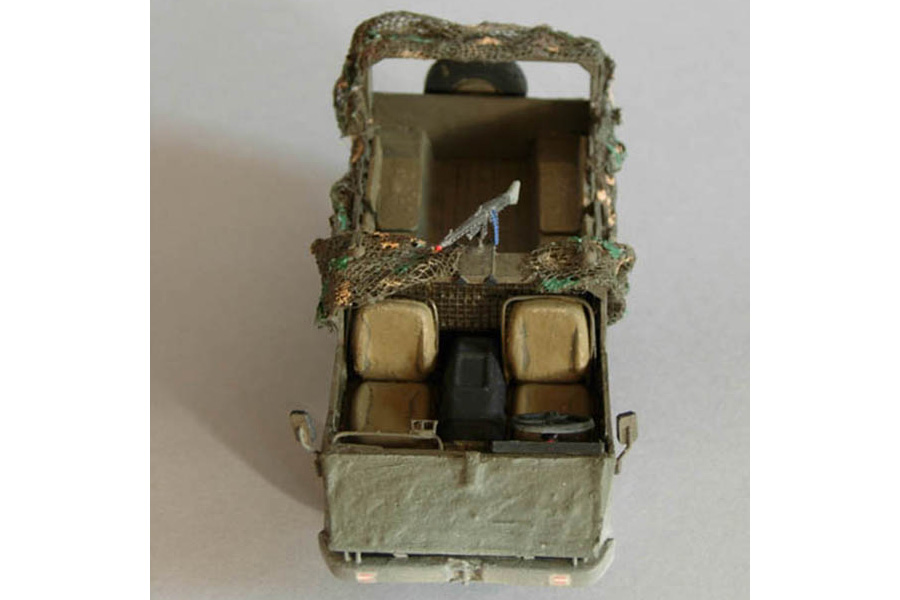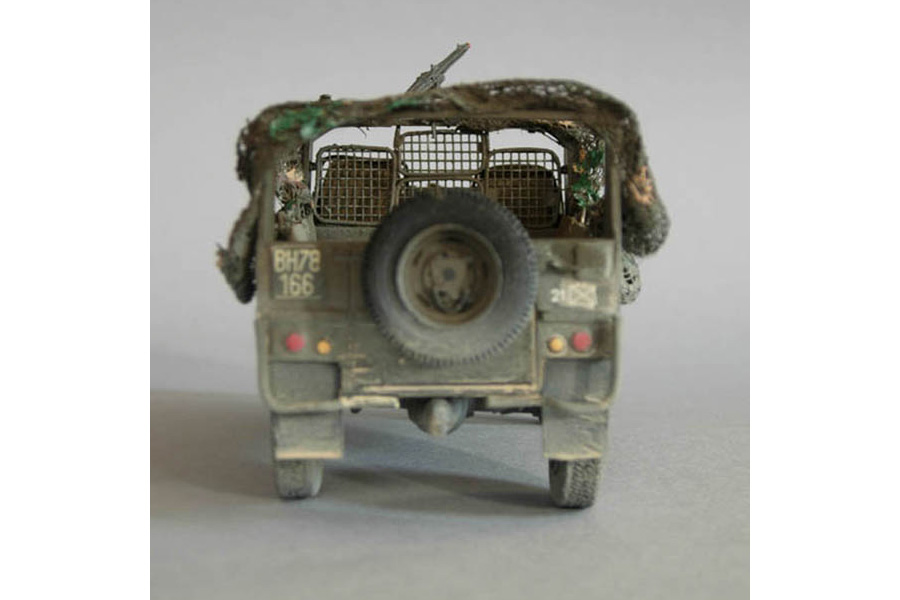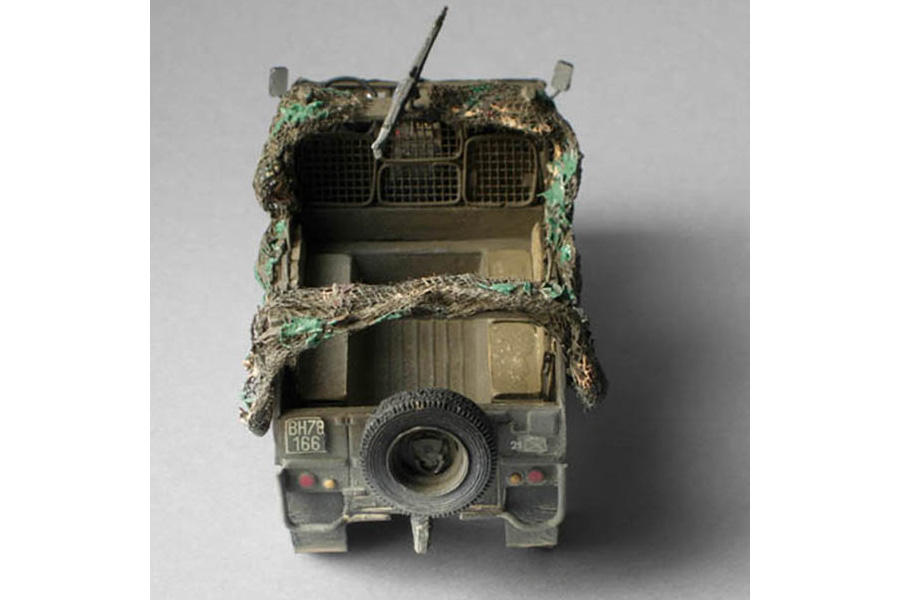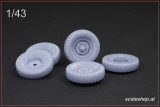Building reports
It is fascinating to see what masterpieces can be created by model builders through the use of various materials and attention to detail. Each of these small masterpieces deserves to be showcased to the public. On this website, we specifically present the Vacu kits from HSV-Modelle. If you have already built a Vacu kit from HSV-Modelle and would like to contribute to enriching the diversity of this website, I would be delighted to hear from you. Your presentation might be just the inspiration other model builders need to try a different type of kit – a so-called Vacu model.
Table of Contents:
- Mountain Rescue Reichenau on the Rax
- Steyr 680 and Saurer Spz (Steyr Helas)
- Steyr 1291 with crane
- Puch 700AP "Haflinger in Congo
- Ă–AF 32.281 FDAK
- Pinzgauer MEDEVAC
- Steyr 12M18 - MINURCAT mission in Chad
- Pinzgauer 710M classic reconnaissance "outfit"
- Building Reports - Found Online
Mountain Rescue Reichenau - Emergency response vehicles
(Mathias Pehofer)
The 100th anniversary of the Mountain Rescue Reichenau on the Rax provided the occasion to build models of the vehicles used at that time, namely the Pinzgauer 710K and the Puch G. The Mountain Rescue Reichenau on the Rax in Lower Austria was founded in 1896 and is one of the most traditional mountain rescue stations in Austria. In 1996, on the occasion of the 100th anniversary, Mathias Pehofer modeled the two vehicles used at that time in 1:35 scale. The Pinzgauer 710K was made from the HSV-103 kit, while the Puch G with a long wheelbase and fixed body was created from the HSV-126 kit. Both kits were initially assembled "out of the box" and then equipped with various self-made parts.
Steyr 680 and Saurer SPz (Steyr Helas)
(Konstantinos Bouris)
Kostas from Greece created models of the Greek Air Force and Army using HSV kits 114 and 201. These vehicles, the Steyr 680 and the Saurer APC (under the designation Leonidas II APC), were produced under license by ELVO and ELBO (later Steyr Hellas) in Greece.
Steyr 1291 with crane
(Alfred Tilek - 2010)
This model is based on the real Steyr 1291 with a crane. Apart from minor modifications such as the spare wheel mount and the side mirror brackets, the model was built "out of the box" from the Steyr 1291-1491 kit (HSV-145). The tipper body was repositioned according to the original dimensions to make space for the fully scratch-built crane.
Puch 700AP "Haflinger" in Congo
(Uwe Schwinghammer)
In brief, Uwe Sch. describes the construction of his Puch 700AP 'Haflinger.' At the time, the Vacu kit (HSV-101) was the only kit of this vehicle in 1:35 scale.
"Although I was accustomed to the peculiarities of Vacu kits, it still took a while for the kit to become a satisfactory model for me. During the build, I decided to assign the 'Haflinger' to the Austrian Army's first foreign mission in 1960 (a field hospital in Congo). The 'Haflinger' was used in the version shown (interestingly, without UN markings). The completed model was incorporated into a vignette, where I placed a Preiser palm tree. The figure is a combination of two old Italeri figures. I started the model with the body. The footwells for the driver and passenger were re-clad externally to maintain the interior dimensions. I also made some changes to the chassis to improve detailing. The resin wheels included in the kit are nicely cast and enhance the model. After assembly, the model was painted white according to the chosen prototype."
Ă–AF 32.281 FDAK
(Stefan Nadler)
This model was based on the extremely rare three-axle Ă–AF 32.281 FDAK truck, which was rarely seen in the Austrian Armed Forces. The two-axle version of this vehicle is much more common. Some pictures of the original from the internet helped me in building this three-axle version. Compared to the two-axle model, the side walls of the tipper body are higher on this vehicle. Implementation was not difficult by adjusting the length and height dimensions of the kit parts based on reference photos. Some other small parts, like the oil filler neck behind the cabin, were also scratch-built. The chassis and cabin were built "out of the box" (HSV-144). For simplicity, I also used the tank from the kit, which should actually be much larger.
Pinzgauer 712 - MEDEVAC
(Ludwig Aschauer)
This model was designed based on a Pinzgauer 712 SAN from the 6th Staff Battalion in Innsbruck. 'With some practice in Vacu construction, it is quite easy to assemble. The fit is adequate, and the instructions leave few questions unanswered. However, filing, puttying, and sanding are essential. For relatively little money, you get a nice basic model that can be completed with scratch-building and numerous reference photos according to your expectations. Due to the variety of detailing options, I now prefer building Vacu models over traditional injection-molded models. The thin wall thickness of the parts gives the model a very realistic, delicate appearance. However, Vacu models are less suitable for beginners, although exceptions do prove the rule.
Scratch-building:
Headlights with brush guards, side mirrors, front and rear bumpers, blue light (LED) with brush guard, wipers, exhaust, tail lights. The tail lights are cut from a TicTac box. The cabin cover is made from silk paper.
Painting:
Model: RAL 7013 (Austrian Armed Forces) - 'Fetzendachl': RAL 7003 satin. The decals are from Schefczik.
Steyr 12M18 - MINURCAT mission in Chad
(Uwe Schwinghammer)
Aside from the usual sanding, filling, and improvisation work that comes with a Vacu model, I was very satisfied with the kit. The individual parts are finely detailed, and the included resin wheels are of very good quality. However, I noticed a small flaw in the kit: the provisional bench behind the driver and passenger seats, which contains storage space, does not match the prototype.
I started building the model with the cab. The bumper needed to protrude a bit more; I have already moved it by 1 mm. Any further adjustment wasn't possible, as it would affect the fitting of other parts. The rest of the assembly went smoothly. The rearview mirrors and windshield wipers will be added after painting. I tried to represent everything as accurately as possible, at least the parts that are visible. Overall, I was quite satisfied with the kit, except for a few minor issues.
My model represents a vehicle from the MINURCAT mission in Chad. The painting is more or less complete. I have already experimented a bit with pigments on the roof and fenders; the rest will follow. The flatbed is not yet fixed in place to facilitate aging of the chassis. However, I noticed a mistake during construction: the tarpaulin bows can be inserted either high or low. The flatbed has both higher and lower hook rows for this purpose. My model has a high build, and the tarpaulin is attached to the lower hooks, which likely wouldn't be the case in reality.
Pinzgauer 710M in classic reconnaissance "outfit"
(Uwe Schwinghammer)
A Pinzgauer 710M in classic reconnaissance "outfit" served as the inspiration for the model: de-militarized, with the windshield folded down, mounted MG, and draped with camouflage nets. The only suitable base for this project was the HSV Vacu kit 102. Using a Vacu kit made the project particularly exciting, as any interior details are missing. Therefore, many reference photos were necessary. In hindsight, I made some more or less noticeable mistakes with this model. The assembly of the raw version of the 710M went very quickly and without difficulties. There were hardly any ambiguities about where each part should go. But then came the details.
The first challenge was the slightly curved roll bars of the Pinzgauer. Despite days of tension with rubber bands, I couldn't get them to look as they should. In the end, this problem was covered up by the camouflage nets. However, one should not forget the small triangles that are attached at all corners to stiffen the bars.
Building the seat benches with the characteristic bars on the backrests, which I bent from thin wire, was also demanding. The best approach is to first draw a template. Unfortunately, I later found that my benches were a bit too short.
The most complex part was the grid between the driver's area and the cargo area or troop compartment. It consists of two large and two small framed grids, with the small ones in the middle able to be folded open. I also drew a template for the frame and bent the parts from thin wire. I used a piece of fly screen for the grid.
The MG mount is a very simple construction: a "board" with a rod where the MG 74 is hooked. This construction is simply clamped onto the roll bar. I made the MG mount from a plastic sheet, added four small black screws at the corners, and attached a rod. Additionally, I added mounts for two antennas on the front roll bar.
Another major task was building the driver's cabin. The Vacu parts in the kit only represent the dashboard and glove compartment. The center console with the brake, gear shift, four-wheel drive, etc., is completely missing. I bent the grab handle on the passenger side from wire and made the rifle mounts from plastic strips. The heater (on the passenger side, bottom left) was made from a piece of copper wire and a small pot. There's no limit to detailing here. A small tip: The rearview mirrors should be rounded a bit more than on my model.
The biggest challenge at the front was the brush guards over the headlights and turn signals. Normally, these are made of three parts (two vertical and one horizontal bar). Since the horizontal bar is hidden under the folded-down windshield, I left it out. The original windshield is also secured with two brackets (left and right of the radiator grille) to prevent it from bouncing around during driving. I cut off the raised headlights and reattached them on the back as reflectors. The lenses in front are made from fairly thick, slightly cloudy plastic discs. The windshield cover has a raised area in the middle where the wiper motor is located on the original.
At the rear, there was a discrepancy between the prototype and the kit. Older Pinzgauers had round taillights, which are also found in the Vacu kit. They also had slightly different bumper mounts on the sides. To resolve this discrepancy, I used a combination of round lights and new-style bumpers for simplicity. The bumpers are made from bent copper wire.
I minimally detailed the chassis, adding suspension and an exhaust pipe.
The model was painted olive green and weathered and dusted. The camouflage nets were made from bandage material and oregano. The tactical badge of the Jägerbataillon 21 consists of parts of a Roco decal and rub-down letters. The old Bundesheer license plate comes from a decal sheet from HSV-Modelle.
Finally, the model was complemented with figures. These come from the M113 kit and the Command Post Set by Tamiya and represent Bundesheer soldiers from the early 1990s. The STG 77 rifles are made of tin and come from HSV-Modelle. When assembling the figures and the Pinzgauer, it becomes evident that either the figures are too large or the Pinzgauer is too small. They would not fit under the tarp while sitting.
Further building reports from HSV models
I also found reports on various model making websites. I am sharing these links with you
| Saurer Beobachtungspanzer A1 | modellversum.de |
| Steyr 680M3 | modellbauseite.at |

